Socket Mobile CHS1 Cordless Hand Scanner Series 7 User Manual Socket Cordless Hand Scanner User s Guide
Socket Mobile, Inc. Cordless Hand Scanner Series 7 Socket Cordless Hand Scanner User s Guide
User Guide
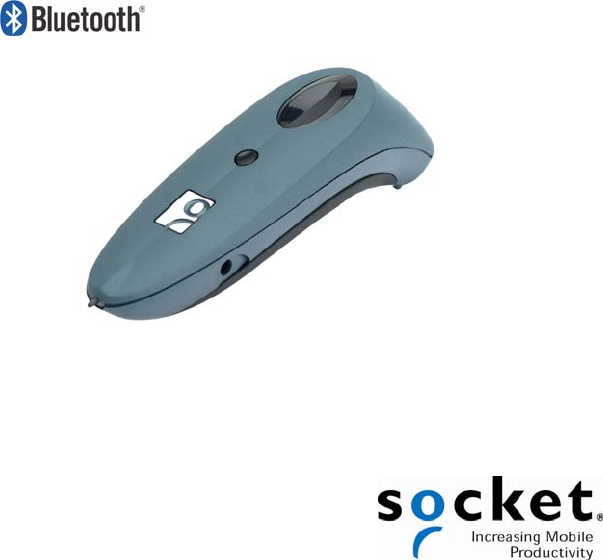
Cordless Hand Scanner Series 7
with Bluetooth® Wireless Technology
Featuring a Bluetooth enabled bar code scanner for wirelessly
adding bar code scanning to Bluetooth enabled mobile computers
running:
• Windows Mobile 2003, 2003SE or 5.0
• Palm OS 5.2 or later
• Windows XP or XP Tablet Edition
User’s Guide

4/2007 Document # 6410-00233 J
COPYRIGHT NOTICE
Copyright © 2007 Socket Communications, Inc. dba Socket Mobile, Inc.
All rights reserved.
Socket, the Socket logo and Battery Friendly are registered trademarks of
Socket Communications, Inc. dba Socket Mobile, Inc. Cordless Hand
Scanner with Bluetooth Wireless Technology, SocketScan, Mobility
Friendly, Connect!Agent, and Error Proof Protocol are trademarks of
Socket Communications, Inc. dba Socket Mobile, Inc. Bluetooth and the
Bluetooth logos are registered trademarks owned by Bluetooth SIG, Inc.,
U.S.A. and licensed to Socket Mobile, Inc. All other brand and product
names are trademarks of their respective holders.
The Cordless Hand Scanner includes technology licensed under United
States Patent Numbers 5,902,991 and D526,320 S.
Reproduction of the contents of this manual without the permission of
Socket Mobile is expressly prohibited. Please be aware that the products
described in this manual may change without notice.
Feel free to contact Socket Mobile at:
Socket Mobile, Inc.
39700 Eureka Drive
Newark, CA 94560-4808
Other than the above, Socket Mobile can assume no responsibility for
anything resulting from the application of information contained in this
manual.
Please refrain from any applications of the Socket Cordless Hand Scanner
that are not described in this manual. Please refrain from disassembling the
Cordless Hand Scanner. Disassembly of this device will void the product
warranty.
You can track new product releases, software updates and technical
bulletins by visiting Socket’s website at: www.socketmobile.com.
TABLE OF CONTENTS
COPYRIGHT NOTICE 2
1 | INTRODUCTION 5
SCANNER VERSIONS 5
ABOUT THE SOFTWARE 5
ABOUT COMBINING SCANNING WITH BLUETOOTH 6
SYSTEM REQUIREMENTS 7
PACKAGE CONTENTS 7
PRODUCT REGISTRATION 8
ADDITIONAL DOCUMENTATION 8
HARDWARE FEATURES 8
2 | HARDWARE PREPARATION 11
INSTALLING BATTERIES AND ATTACHING THE TETHER 11
CHARGING THE SCANNER 12
3 | SETUP FOR WINDOWS MOBILE 13
STEP 1: INSTALL THE SOFTWARE 14
STEP 2: CONFIGURE SCANNER SETTINGS 16
STEP 3: CONNECT CHS TO HOST DEVICE WITH BLUETOOTH 18
STEP 4: SCAN DATA INTO YOUR APPLICATION 20
SELECTING SYMBOLOGIES 23
CONFIGURING PREFIXES/SUFFIXES 24
CONFIGURING SOUNDS 25
RUNNING SCAN DEMO 26
USING THE CONNECT!AGENT UTILITY 27
4 | SETUP FOR PALM 29
STEP 1: INSTALL THE SOFTWARE 30
STEP 2: CONNECT CHS TO PDA WITH BLUETOOTH 31
STEP 3: SCAN DATA INTO YOUR APPLICATION 34
CONFIGURING SCAN SETTINGS 36
SELECTING SYMBOLOGIES 38
TESTING BAR CODES 39
5 | SETUP FOR WINDOWS XP 40
STEP 1: INSTALL THE SOFTWARE 41
STEP 2: CONFIGURE BLUETOOTH SETTINGS 43
STEP 3: CONFIGURE SCANNER SETTINGS 49
STEP 4: START SOCKETSCAN AND CONNECT TO CHS 51
STEP 5: SCAN DATA INTO YOUR APPLICATION 52
ASSIGNING SOUND AND PREFIX/SUFFIX SETTINGS 54
CONFIGURING ADVANCED BLUETOOTH SETTINGS 55
ASSIGNING A TRIGGER BUTTON 57
SELECTING SYMBOLOGIES 58
3

1 | INTRODUCTION
If you need to collect bar coded data but don't want to be tied to your mobile
or desktop computer, Socket's Cordless Hand Scanner (CHS) Series 7 with
Bluetooth wireless technology is just what you're looking for. This
innovative device combines the power of laser bar code scanning with the
convenience of Bluetooth wireless technology in a single compact,
lightweight device that is ergonomically designed to fit comfortably in the
palm of your hand.
Bar code scanning is the most efficient way to collect data from a mobile
computer. If the data to be entered is bar coded, using a laser scanner is 50
times faster and 10,000 times more accurate than manual data entry.
Bluetooth wireless technology transforms how devices connect with each
other, offering you new possibilities for using your mobile computer with
other devices. With Socket's Cordless Hand Scanner (CHS), you can scan
bar codes while connected to the PDA in your pocket or to your laptop,
tablet or desktop computer located up to 300 feet away — all without the
hassle of cables or the awkwardness of a protruding antenna.
SCANNER VERSIONS
The CHS Series 7 includes three versions of the scanner.
• The entry-level CHS 7E uses linear CMOS imaging technology.
• The mid-level CHS 7M has a Class 1 laser scanner.
• The performance level CHS 7P features a Class 2 laser scanner and a
ruggedized construction.
ABOUT THE SOFTWARE
SocketScan™ enters scanned data directly into any open
Windows or Palm OS program as if the data were manually
typed, so you can use the CHS with your favorite application.
Included is a utility that enables you to configure
Prefix/Suffixes, sounds, and other special settings for the CHS.
Connect!Agent™ for Windows Mobile and XP simplifies Bluetooth by
automatically setting up and managing the wireless connection.
Connect!Agent runs in the background, requiring no user interaction.
CHAPTER 1: INTRODUCTION 5
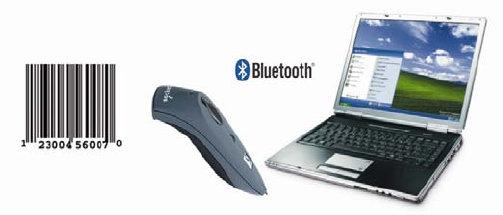
ABOUT COMBINING SCANNING WITH BLUETOOTH
The Cordless Hand Scanner represents an optimal combination of proven
laser bar code scanning and state-of-the-art Bluetooth connectivity. Because
of the problems inherent in the intermittent storage of scanned data in on-
board memory if the Bluetooth connection is lost, the CHS is designed to
operate only when connected to the host, with the powerful Class 1 radio
providing the maximum possible connection range.
The user is advised of the connection status with a single beep when the
CHS connects to the host and a double beep when the connection is closed
or lost. As with any wireless device, connectivity range can be affected by a
variety of environmental variables.
The most likely source of errors in any cordless scanning system is not in
the scanning and decoding process, but in the transmission of the data to the
host. For this reason, the Cordless Hand Scanner features Socket’s
exclusive Error Proof Protocol (patent pending), which ensures that
scanned data is correctly received by the host computer and allows for real-
time validation of data and notifies the user in case of errors.
The beeper and green LED signals provided by the CHS confirm not only a
successful scan but also the successful transmission of the scanned data to
the host. Users familiar with bar code scanning may notice a slight delay
between the successful scan and shut off of the laser, and the beep and
green LED from the CHS confirming completed transmission of the data. In
most instances, this delay is less than 300 ms (milliseconds), but may be
slightly longer as the connectivity range limit is approached.
Because of the two-way transmission verification process, it is possible to
cause communication problems by scanning bar codes as fast as possible.
When this occurs, all transmissions will stop for several seconds before
scanning can be resumed. To prevent this from happening, the user should
6
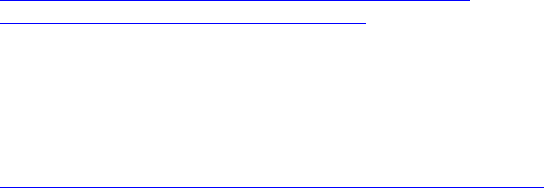
wait until the confirming beep is received before scanning the next bar
code.
SYSTEM REQUIREMENTS
Windows Mobile devices should satisfy these minimum requirements:
• Windows Mobile 2003, 2003SE or 5.0
• Any of the following Bluetooth stacks:*
− Broadcom (Widcomm) v1.5 or greater for Windows Mobile 2003/2003SE
− Broadcom (Widcomm) v1.7 or greater for Windows Mobile 5.0
− Microsoft Bluetooth stack for Windows Mobile
− Socket Drakar v1.4 (from Socket SD/CF Connection Kits)
• Software installation requires either ActiveSync 4.0 or greater or
Windows Vista on a host computer.
Palm OS devices should satisfy these minimum requirements:
• Palm OS 5.2 or later
• Bluetooth wireless technology
• Software installation requires Palm Desktop Software on a host
computer.
Windows XP computers should satisfy these minimum requirements:
• Windows Mobile XP or XP Tablet Edition
• Any of the following Bluetooth stacks:*
− IVT BlueSoleil version 1.6.1.4 (from Socket CF/USB Connection Kits)
− Microsoft Windows XP Service Pack 2 Bluetooth stack
− Toshiba Bluetooth stack 3.0 or greater
− Broadcom (Widcomm) Bluetooth stack
For information about using the CHS with Symbian smartphones or RIM
BlackBerry devices, please visit:
www.socketmobile.com/products/bar-code-scanning-data-
collection/series7/default.asp?page=summary
*Other stacks may be compatible but have not been tested by Socket. For
Windows XP, only the IVT, Microsoft, and Toshiba Bluetooth stacks are
compatible with the optional Socket Connect!Agent software.
For software updates, please visit:
www.socketmobile.com/support/downloads/data-collection/series7/
PACKAGE CONTENTS
The Socket Cordless Hand Scanner package includes these items:
CHAPTER 1: INTRODUCTION 7

• Socket Cordless Hand Scanner with Bluetooth Wireless Technology
• AC charging adapter with international plugs
• 2 NiMH rechargeable AAA batteries
• Lanyard with retractable tether
• Software Installation CD
• Booklets with copyright, warranty, and regulatory compliance
information
PRODUCT REGISTRATION
Socket highly recommends that all customers register their Socket products.
Registered users receive the following benefits:
• Priority for technical support
• Special offers for future products and upgrades
• The latest new product information.
Register online at: www.socketmobile.com/support/support/new
ADDITIONAL DOCUMENTATION
Besides this User’s Guide, Socket also supports the Cordless Hand Scanner
Series 7 with Quick Start Guides and Advanced Programming Guides,
available online at: www.socketmobile.com/support/downloads/data-
collection/series7/?page=Detail
HARDWARE FEATURES
Rechargeable Batteries and AC Adapter
Charge the internal batteries by using the included AC adapter. The adapter
rating is 5V, 2A, positive pole center. A fully charged battery should
provide roughly 8 hours of normal operation.
WARNING: Charge ONLY NiMH batteries in the CHS. Damage may
result if other battery types are charged. Do not store the CHS for more
than 30 days with the batteries installed.
The red Battery Status LED will not function properly if standard AAA non-
rechargeable batteries are being used.
Besides the included AC adapter, you can also recharge the CHS by using
any of the following:
• Socket’s Mobile Power Pack (available only in the Americas and Asia
Pacific regions). For more information, please visit:
www.socketmobile.com/products/accessories/mobile-power-pack/
8
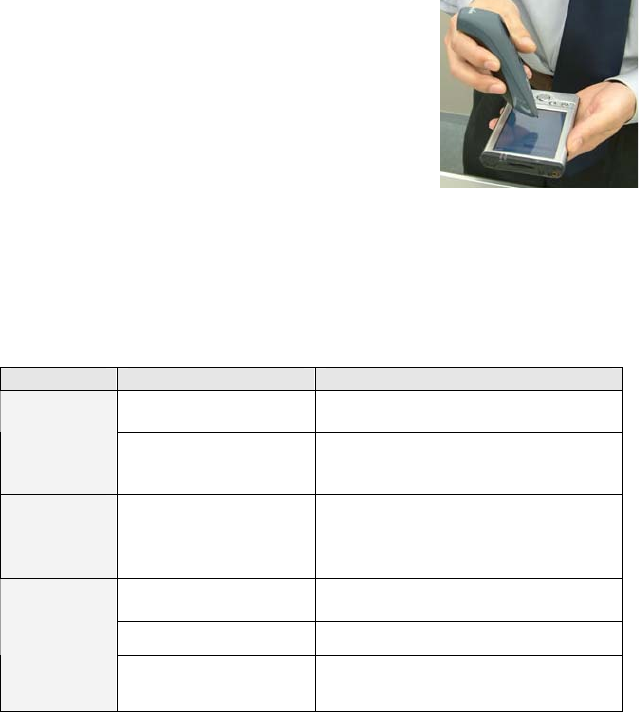
• AC and DC adapters of most recent Pocket PCs from Socket Casio,
Dell, Fujitsu, HP, and Toshiba are also compatible.
Touch Screen Stylus
The CHS features a stylus tip in the tail of the CHS
that you can use Pocket PC and other device touch
screens. The stylus can be removed with small pliers
if desired. Visit the Socket website to purchase
replacement styli.
WARNING: Do not use the stylus if damaged. A
damaged stylus may scratch the display screen
of your computer.
The stylus does not work with XP Tablet computers using Active Matrix
displays.
Status Indicator LED
LED LED Activity Meaning
1 blink per second Bluetooth radio is on, but not
connected.
Bluetooth
Status
(Blue)
1 blink per 5 seconds Bluetooth radio is on, connection
established.
Good Read
(Green)
Green Data successfully scanned and
transmitted to host device.
1 blink per second Less than 20% of battery life
remaining.
Solid red Batteries are charging.
Battery
Status
(Red) Off when connected
to charger Batteries are fully charged.
CHAPTER 1: INTRODUCTION 9
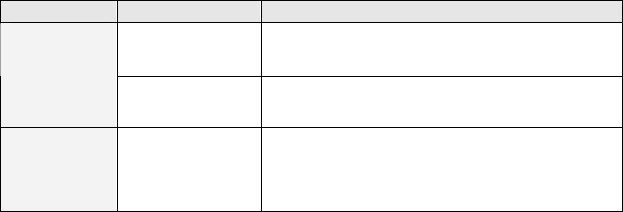
Status Indicator Beeps
The scanner beeps to signal the Bluetooth connection status. You can also
have the scanner beep to indicate scanned data reaching the host device.
LED Beep Pattern Meaning
1 beep Connection to host device has begun.
Bluetooth
Status
(Blue)
2 beeps Connection to host device has ended.
Good Read
(Green)
1 beep Data was successfully scanned and
transmitted to host device.
10
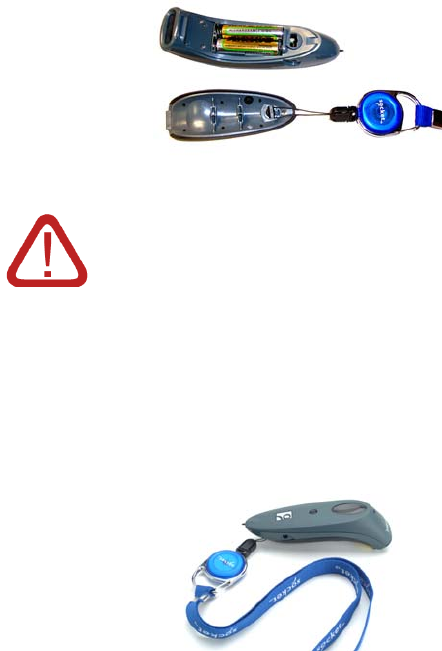
2 | HARDWARE PREPARATION
INSTALLING BATTERIES AND ATTACHING THE TETHER
1. Use a coin or screwdriver to unlock and remove the battery cover. Turn
the lock underneath the scanner to a horizontal position. Remove the
casing.
2. Install the batteries in opposite directions, as indicated by the positive
symbols.
WARNING: Do not install the batteries incorrectly.
Damage may result.
3. If desired, attach the tether. Wrap the string loop around the inside part
of the lock.
4. Replace the battery cover and lock it into place.
5. If desired, attach the tether to a lanyard or belt.
CHAPTER 2: SETUP FOR WINDOWS MOBILE 11

CHARGING THE SCANNER
Use the included AC adapter to charge the Cordless Hand Scanner. The
scanner’s NiMH batteries must be charged for at least 4 hours before the
first use. The Battery Status LED will emit a solid red light while charging,
and turn off when the batteries are fully charged.
WARNING: Do not attempt to charge alkaline batteries
— this may cause alkaline batteries to leak and damage
the CHS.
The red Battery Status LED will not function properly if
standard AAA alkaline batteries are being used.
12

3 | SETUP FOR WINDOWS MOBILE
This chapter explains how to install and use the
Cordless Hand Scanner (CHS) with a Bluetooth
enabled Pocket PC or other mobile computing device
running Windows Mobile 2003, 2003SE or 5.0.
Before you begin the instructions in this chapter,
make sure you have installed the batteries (and tether,
if desired), and charged the scanner, as described in
Chapter 2, “Hardware Preparation.”
SETUP SUMMARY
STEP 1: Install the software.
STEP 2: Configure scanner settings.
STEP 3: Connect scanner to host device with Bluetooth.
STEP 4: Scan data into your application.
Selecting symbologies
Configuring prefixes/suffixes
Configuring sounds
Running Scan Demo
Using the Connect!Agent Utility
CHAPTER 2: SETUP FOR WINDOWS MOBILE 13
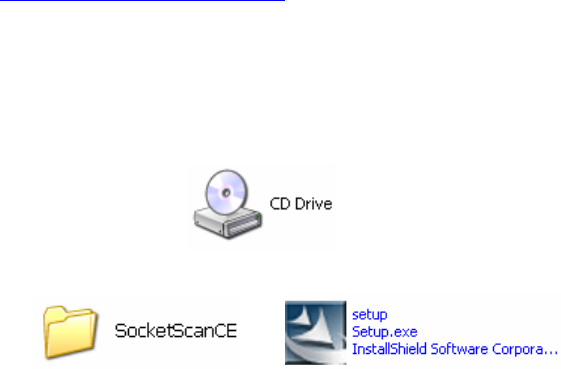
STEP 1: INSTALL THE SOFTWARE
You must install both SocketScan and Connect!Agent.
ADVANCED USERS: Refer to the README file for CAB installation instructions.
1. Delete any bar code scanning software already installed in your device,
including software from other companies. Make sure the software is
closed. Tap Start | Settings | System tab | Remove Programs. Use the
utility to delete the software.
2. Use a serial/USB cable or cradle to make an active connection between
the mobile computer and a host PC.
• If your host PC runs Windows XP, use ActiveSync 4.0 or greater. You
can download ActiveSync free from:
www.socketmobile.com/activesync
• If your host PC runs Windows Vista, use the Windows Mobile Device
Center built into Windows Vista.
3. Insert the installation CD into your host PC.
4. Use My Computer or Windows Explorer to access your CD drive.
5. In the CD, open the SocketScanCE folder and click on Setup.exe.
6. The installation wizard will automatically begin. Follow the wizard to
install the software.
14

7. After installing the software, a dialog on your Pocket PC will direct
you to soft reset. Tap ok.
8. Remove your device from the cable/cradle and perform a soft reset by
pressing the reset button. If you skip this step, some icons may not
appear correctly.
9. Install Connect!Agent by opening the Connect!Agent folder in the CD
and clicking on Connect!AgentSetup.exe. Follow the wizard to install the
software.
CHAPTER 2: SETUP FOR WINDOWS MOBILE 15

STEP 2: CONFIGURE SCANNER SETTINGS
1. Tap Start | Programs | SocketScan.
2. Go to the Today screen by tapping Start | Today.
3. Tap the SocketScan icon at the bottom of the screen. In the pop-up
menu, tap Settings.
4. The Scanner Settings utility will appear. Tap on the CS tab at the bottom
of the screen.
5. Check the box Enable Cordless Scanner support. IMPORTANT!!!
16
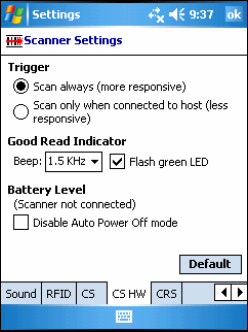
6. Tap on the CS HW tab. Enter the following settings:
• Trigger: Select whether you would like the CHS to scan only when a
Bluetooth connection to the device is detected. If you require the
CHS to detect a Bluetooth connection before each scan, scanning
will be a few milliseconds slower.
• Good Read Indicator: Select how you would like the CHS to indicate
that it has successfully read data.
• Battery Level: No progress bar should appear since you are not
connected to the CHS.
• Disable Auto Power Off mode: The CHS automatically shuts off if
there is no Bluetooth connection for 20 minutes. Check to disable.
7. After entering settings, tap ok to save the changes.
CHAPTER 2: SETUP FOR WINDOWS MOBILE 17
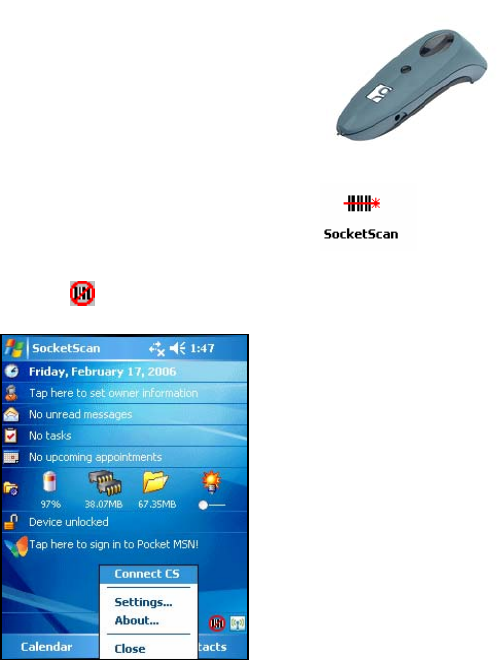
STEP 3: CONNECT CHS TO HOST DEVICE WITH BLUETOOTH
SocketScan supports a generic Bluetooth COM port and may be able to
connect to Bluetooth stacks on mobile computers other than those listed.
1. Turn on the Cordless Hand Scanner. Press the small
power button for five seconds, until you see the LED
turn blue. The LED should blink blue once every second
to show that the Bluetooth radio is on but not connected.
If the LED begins blinking red, the battery needs to be
recharged.
2. Tap Start | Programs | SocketScan.
Disregard the icons for Socket Trigger RFID,
Socket Trigger Scan, and Socket Trigger Select.
3. Tap on the SocketScan icon at the bottom of the screen. In the menu,
tap Connect CS.
Your mobile device cannot connect to the CHS if another device is set as
the default Bluetooth serial device.
If Connect CS does not appear, tap Settings in the menu, tap on the CS
tab, and enable cordless scanner support.
4. Connect!Agent will automatically turn on the Bluetooth radio and begin
to search for and connect to the CHS.
- If this is your first time connecting to a CHS or CRS (Cordless Ring
Scanner) from this device, Connect!Agent will begin searching for
any CHS or CRS in range.
18
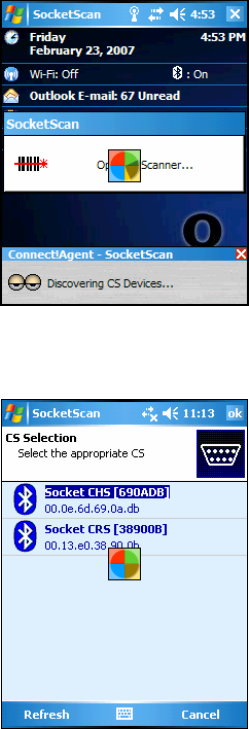
- If you have previously connected to a CHS or CRS, Connect!Agent
will automatically begin searching for your favorite (default)
device.
5. If Connect!Agent does not have a favorite scanner and finds multiple
CHS and/or CRS devices in range, select the one you want to connect to
and tap ok.
To help you identify the scanner, Connect!Agent reports the scanner’s
Bluetooth MAC address. The characters in brackets are the last six
characters of the address.
CHAPTER 2: SETUP FOR WINDOWS MOBILE 19
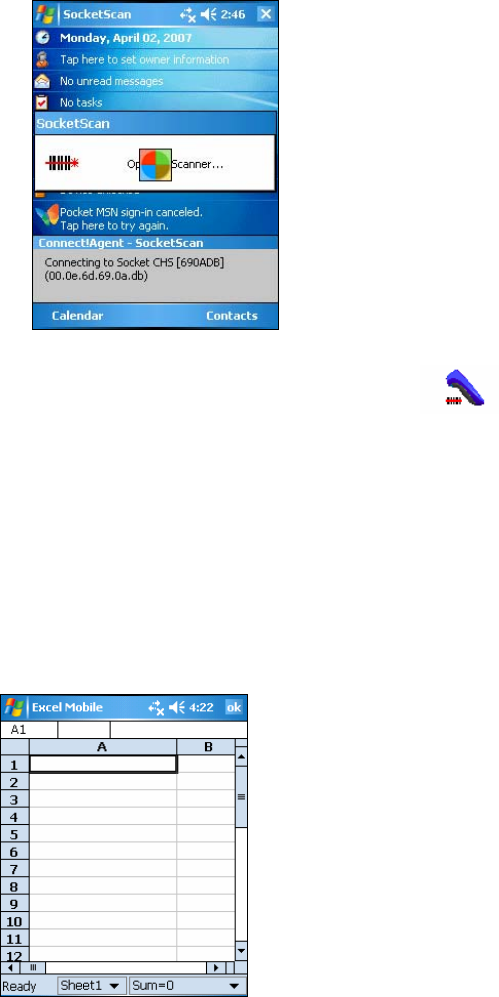
6. Connect!Agent will begin connecting to the CHS.
7. After your mobile device connects to the CHS, the scanner will beep
once. The SocketScan icon at the bottom of the Today screen will
change into a scanner icon to indicate the connection.
Connect!Agent will save information about the CHS to automate future
connections to your specific unit.
To change which scanner is assigned as your favorite, you can also use
the Connect!Agent utility. (See instructions later in this chapter.)
STEP 4: SCAN DATA INTO YOUR APPLICATION
1. Start the Windows application that you want to receive the data (e.g.,
Excel, Notepad, etc.). Make sure a document or spreadsheet is open.
2. Place the cursor where you want data from the next scan to go.
20

3. Press the trigger button and scan the code.
When data is read and sent to the mobile computing device, the laser will
turn off. Depending on your scanner settings, the scanner may beep
and/or the Hand scanner’s LED may flash green to indicate a good
read.
If no data is read in a few seconds, the laser will turn off, and you must
try again.
4. After a successful scan, data should appear in your document. For
example, after you scan a bar code into a Pocket Excel spreadsheet, data
should appear in the first cell. The default “CR” (carriage return) suffix
will advance the cursor to the next cell, ready for the next scan.
Wait for the “Good Scan” indication before you scan another bar code.
If you try to scan too fast, the device can lock up until you stop
scanning.
CHAPTER 2: SETUP FOR WINDOWS MOBILE 21
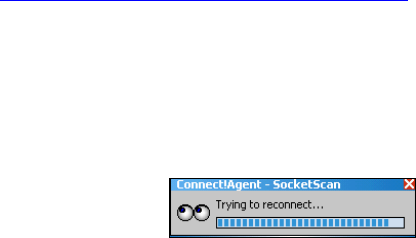
For information about third-party applications compatible with the CHS
for asset tracking, health care, and other vertical markets, visit:
www.socketmobile.com/solutions/vertical-markets/
Reconnecting
If your mobile device suspends or the CHS moves out of range, the
connection will end. After the mobile device turns on again or returns in
range, SocketScan will try to re-connect 3 times. If, after 3 attempts,
they have not re-connected, you will need to manually re-connect them.
Disconnecting
To disconnect, tap on the SocketScan icon at the bottom of the Today
screen and tap Disconnect. Your mobile device will disconnect from the
CHS, and Connect!Agent will turn off the Bluetooth radio of your
mobile device.
Turning off the CHS
To turn off the CHS, press the power button at least 2 seconds, until the
LED stops blinking.
22

SELECTING SYMBOLOGIES
The applet makes it quick and convenient to modify which symbologies
you want the scanner to recognize. By default, the scanner is set to
recognize nine of the most common symbologies.
1. Tap on the SocketScan icon. In the pop-up menu, tap Symbology Selector...
2. In the screen that appears, check the symbologies you wish to enable.
Uncheck those you wish to disable. For convenience, you can tap
Disable All to disable all the symbologies and select the ones you want.
Tap ok.
Symbologies not supported by the CHS will be gray.
Enabling all possible symbologies will make the decode
process slightly longer.
CHAPTER 2: SETUP FOR WINDOWS MOBILE 23

CONFIGURING PREFIXES/SUFFIXES
The SocketScan applet lets you specify prefix and/or suffix characters to be
added automatically to the data you scan. This helps to further eliminate
manual data entry.
1. Tap on the SocketScan icon. In the pop-up menu, tap Settings.
You can configure prefix/suffixes whether or not the CHS is
connected to your Pocket PC.
2. In the pop-up menu, select Settings...
3. In the screen that appears, enter the characters you want to be appended
to each scan (128 character maximum). Tap ok.
By default, SocketScan enters a carriage return after every data scan.
• Use \r for Carriage Return, \n for Linefeed, \t for Tab., \\ for a single \
character.
• Other characters can be typed or entered using the format \nnn, where
nnn = ASCII character 001 through 255.
24
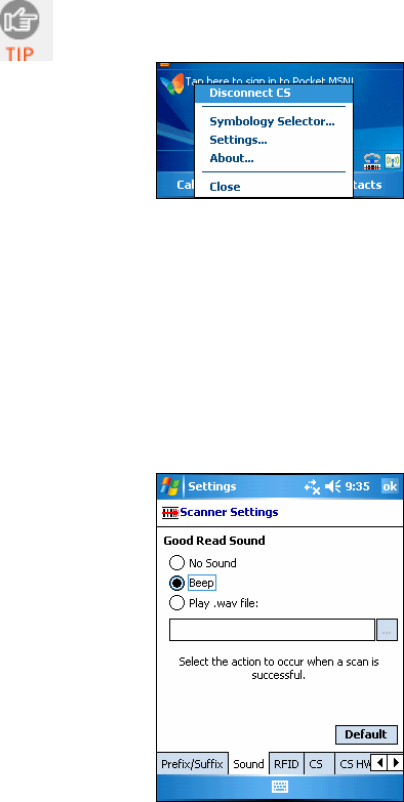
CONFIGURING SOUNDS
The SocketScan applet lets you specify sounds used to indicate when the
CHS has successfully scanned data and transmitted it to the host device.
1. Tap on the SocketScan icon. In the pop-up menu, tap Settings.
You can configure sounds whether or not the CHS is connected
to your Pocket PC.
2. The Scanner Settings utility will appear, with the Prefix/Suffix tab open.
Tap on the Sound tab.
3. Select which sound you want your mobile computer to use to indicate a
good read.
If you select Play .wav file, tap on the … button to search for the .wav file
you want to use (the file must be located in the My Documents folder).
Tap ok.
CHAPTER 2: SETUP FOR WINDOWS MOBILE 25
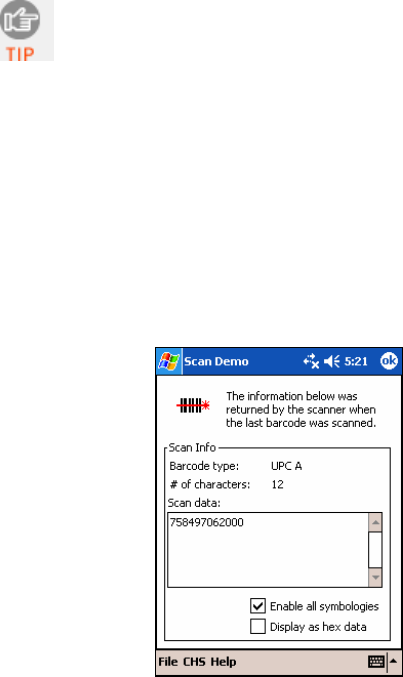
RUNNING SCAN DEMO
Scan Demo makes it easy to determine the symbology, number of
characters, and decoded data (in either ASCII or Hex) of any bar code
supported by the scanner. This is especially useful if you encounter a bar
code that the scanner will not decode by default.
1. Tap Start | Programs | Scan Demo.
Accessing Scan Demo disconnects the Bluetooth link. If you
have not configured the CHS to automatically connect, select
the CHS tab at the bottom of the page to re-establish this link.
2. The Scan Demo screen will appear. If desired, use the check boxes at
the bottom of the screen to modify the test.
Enable all symbologies: By default, this option is checked. Different
symbologies can sometimes interpret the same bar code differently, so
you may want to uncheck this option.
Display as hex data: Check this box to view scanned data in hexadecimal
format. Otherwise, data will appear as ASCII.
3. Scan the bar code. Scan Demo will report the properties of the bar code.
26

USING THE CONNECT!AGENT UTILITY
The Connect!Agent utility enables you to view and change the default
Cordless Hand Scanner, Cordless Ring Scanner or Cordless 56K Modem
that Connect!Agent will attempt to connect to.
1. Tap Start | Settings | System tab | Connect!Agent.
2. The Connect!Agent utility lists the wireless bar code scanners and/or
modems that it has saved as favorite devices. These are specific devices
that Connect!Agent automatically attempts to connect to whenever
SocketScan or a Bluetooth dial-up connection is initiated.
CHAPTER 2: SETUP FOR WINDOWS MOBILE 27

3. If you wish to remove a device from the partnership list, select the
device and tap Delete. In the confirmation screen, tap Yes.
28
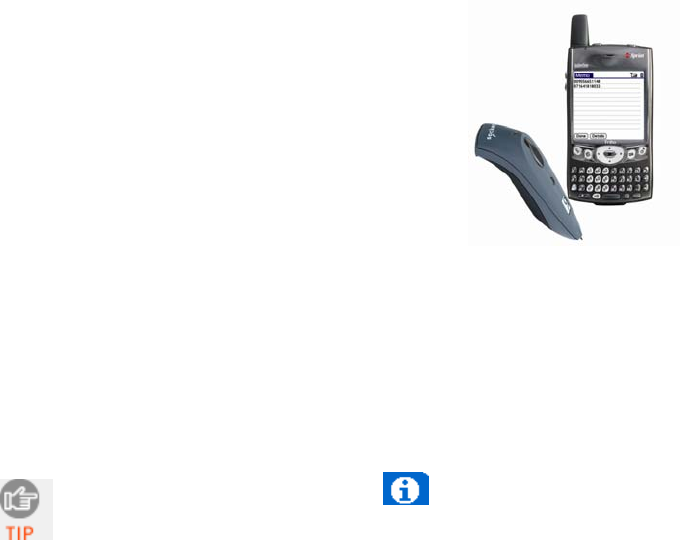
4 | SETUP FOR PALM
This chapter explains how to install and use the
Cordless Hand Scanner (CHS) with a Bluetooth
enabled device running Palm OS 5.2 or later.
Before you begin the instructions in this chapter,
make sure you have installed the batteries (and
tether, if desired), and charged the scanner, as
described in Chapter 2, “Hardware Setup.”
SETUP SUMMARY
STEP 1: Install the software.
STEP 2: Connect scanner to PDA with Bluetooth.
STEP 3: Scan data into your application.
Configuring scan settings.
Selecting symbologies.
Testing bar codes.
For help using SocketScan, tap on the button on the top of
any screen.
CHAPTER 3: SETUP FOR PALM 29

STEP 1: INSTALL THE SOFTWARE
1. Delete any bar code scanning software already installed in your device,
including previous versions of SocketScan. Make sure the software is
closed. Tap Home, then tap Menu. In the App menu, tap Delete. Use the
utility to delete the software.
2. Use HotSync and a serial/USB cable or cradle to connect your device to
a host PC.
3. Insert the installation CD into your host PC.
4. Use My Computer or Windows Explorer to access your CD drive.
5. In the CD, open the SocketScanPalm folder and click on Setup.
6. The SocketScan Installation program will begin. Follow the instructions
on your screen to install the software.
7. When software installation is complete, disconnect the device from the
host PC. Soft reset the device by pressing the reset button.
30
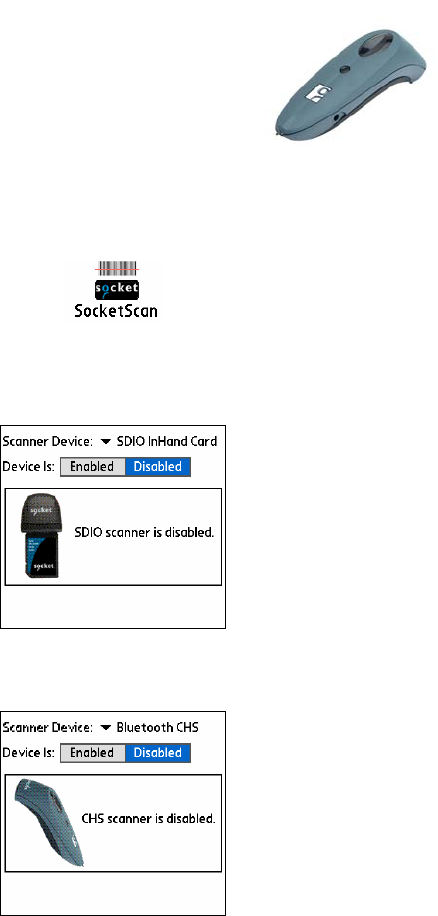
STEP 2: CONNECT CHS TO PDA WITH BLUETOOTH
**SocketScan supports a generic Bluetooth COM port and may be able to
connect to Bluetooth stacks on host mobile computers other than those
listed.
1. Turn on the Cordless Hand Scanner. Press the
small power button for five seconds, until you
see the LED turn blue. The LED should blink blue
once every second to show that the Bluetooth radio
is on but not connected. If the LED begins
blinking red, the battery needs to be recharged.
2. Start SocketScan. Tap Home. In the upper right
corner, make sure All is selected. Scroll down and tap on the SocketScan
icon.
3. The main screen of SocketScan will appear, showing a picture of the
Socket SDIO In-Hand Scan Card. In the Scanner Device drop-down
menu, select Bluetooth CHS.
4. The screen will display a picture of the Cordless Hand Scanner. In the
Device is field, tap Enabled.
CHAPTER 3: SETUP FOR PALM 31
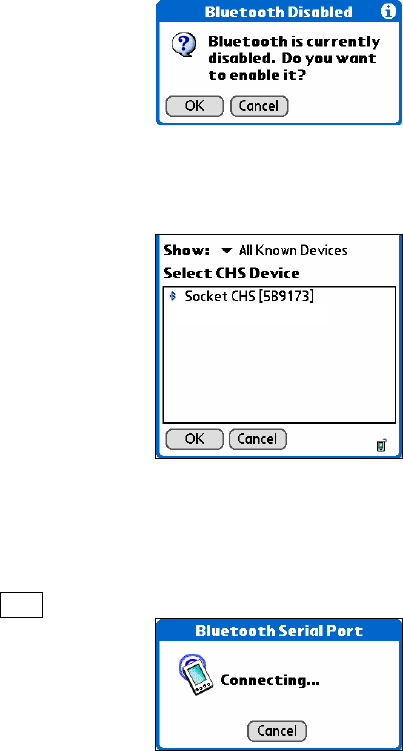
5. If you have not yet enabled your Bluetooth hardware, a message will ask
if you wish to do so. Tap OK.
6. Your device will begin searching for Bluetooth enabled devices in
range. After it finishes searching, select the Socket CHS from the list of
discovered devices and tap OK.
The Cordless Hand Scanner will appear as Socket CHS [xxxxxx], where
the characters in brackets are the last 6 characters of the scanner’s
Bluetooth MAC address.
7. Your device will connect to the CHS. If a passkey is requested, enter
1234.
32

8. When the scanner connects to your device, the CHS will beep once. The
main screen of SocketScan will also indicate that the scanner is enabled,
and the Configure, Symbologies, and Test buttons will appear at the
bottom of the screen.
If the PDA suspends, the CHS will automatically re-connect
once you turn on the PDA again.
If the CHS is taken out of range, or if the Bluetooth connection
is otherwise lost, to resume operation you must enable it again
in SocketScan.
For more information about the meanings of LEDs and beeps,
please see page 9.
CHAPTER 3: SETUP FOR PALM 33

STEP 3: SCAN DATA INTO YOUR APPLICATION
1. Start the Palm application that you want to receive the data (e.g.,
Memo). Make sure a document or spreadsheet is open.
Note: You cannot scan data into Palm Note Pad, because it is a
graphics-based program.
2. Press the trigger button and scan the code.
When data is read and transmitted to the host, the laser will turn off.
Depending on the settings chosen in the SocketScan Configure screen,
the scanner may beep and/or the LED may flash green.
If the Scanner fails to read data within a few seconds, the laser will turn
off, and you must try again.
34

3. After a successful scan, data should appear in your document. For
example, after you scan a bar code into a Memo, data should appear in
the first line. The default “CR” (carriage return) suffix will advance the
cursor to the next line, ready for the next scan.
Wait for the “Good Scan” indication before you scan another bar code.
If you try to scan too fast, the device can lock up until you stop
scanning.
For information about bar code scanning applications for asset tracking,
health care and other vertical markets, please visit:
www.socketmobile.com/solutions/vertical-markets/
CHAPTER 3: SETUP FOR PALM 35
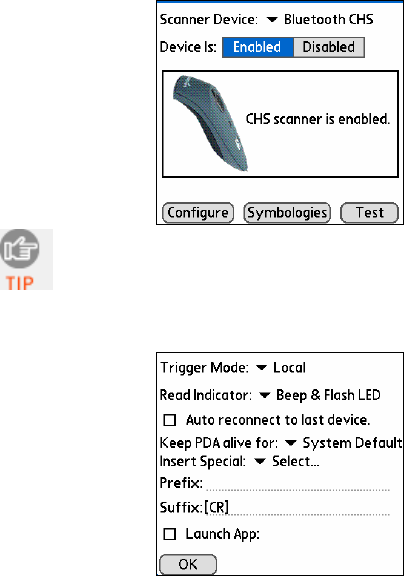
CONFIGURING SCAN SETTINGS
1. Make sure the main screen of SocketScan reports that the CHS is
enabled. Tap Configure.
You can configure prefix/suffixes whether or not the CHS is
connected to your device.
2. The Configure screen will appear. Enter any settings, as desired:
• Trigger Mode: Select Local to directly trigger the scanner whenever
you press the trigger button. Select Remote to have the scanner
verify a connection to your PDA before it activates the laser.
• Read Indicator: Select how you would like the CHS to indicate that
data was successfully decoded and transmitted to the PDA.
• Auto reconnect to last device: Check to have your PDA automatically
connect to the last CHS unit it connected to whenever you tap
Enabled in the main screen of SocketScan.
• Keep PDA alive for: Select how long you would like the PDA to stay
alive after the last scan. This feature allows you to scan data for
several hours without touching the PDA, as long as you scan at least
once before the time limit passes. Select System Default to keep your
PDA alive for the amount of time set as default in the PDA’s system
settings.
36

• Insert Special: First tap in the Prefix or Suffix field to indicate where
you would like to enter special data, such as a date stamp, time
stamp, tab, etc. Then tap on the Insert Special drop-down menu and
select the type of special data to enter.
• Prefix: Tap to enter characters you would like appended before
scanned data (128 character maximum). Besides special data items,
only printable ASCII characters can be used.
• Suffix: Tap to enter characters you would like appended after
scanned data (128 character maximum). Besides special data items,
only printable ASCII characters can be used. The default suffix is a
carriage return [CR].
• Launch App: Check the box, then use the drop-down menu that
appears to select an application that you would like SocketScan to
automatically enter data into whenever you press the trigger button.
The application will launch only when you are outside of
SocketScan (i.e., SocketScan is running in the background).
If you configured SocketScan to launch an application,
whenever you scan data into a document, the data will only be
entered after any existing data, no matter where you place the
cursor. You will not be able to scan data into the middle of
existing data.
For example, if you already scanned three lines of data into
Memo, the next data you scan will appear on the fourth line,
even if you place the cursor on a previous line before scanning.
3. After entering any settings, tap OK to make the changes take effect.
CHAPTER 3: SETUP FOR PALM 37

SELECTING SYMBOLOGIES
The feature makes it easy to modify which symbologies you want the
scanner to recognize. By default, the scanner is set to recognize eight of the
most common symbologies.
1. In the main screen of SocketScan, tap Symbologies.
2. In the screen that appears, check the symbologies you wish to enable.
Uncheck those you wish to disable. Tap OK.
Enabling all possible symbologies will make the decode
process slightly longer.
38
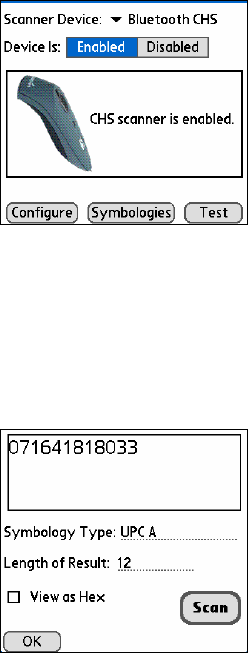
TESTING BAR CODES
SocketScan includes a Test feature that makes it easy to determine the
symbology, number of characters, and decoded data (in either ASCII or
Hex) of any bar code supported by the scanner. This is especially useful if
you encounter a bar code that the scanner will not decode by default.
1. In the main screen of SocketScan, tap Test.
2. The Test Scan screen will appear. If desired, check the View as Hex box
to view scanned data in hexadecimal format. Otherwise, data will appear
as ASCII.
3. Scan the bar code. You can either press the trigger button on the CHS,
or press the Scan button on the screen. SocketScan will report the
properties of the bar code.
4. After you complete your testing, tap OK.
CHAPTER 3: SETUP FOR PALM 39
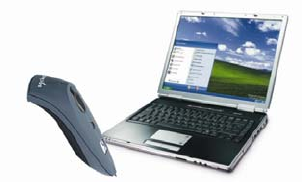
5 | SETUP FOR WINDOWS XP
This chapter explains how to install and use the
Cordless Hand Scanner (CHS) with a Bluetooth
enabled computer running Windows XP or
Windows XP Tablet Edition.
Before you begin the instructions in this chapter,
make sure you have installed the batteries (and
tether, if desired), and charged the scanner, as
described in Chapter 2, “Hardware Setup.”
SETUP SUMMARY
STEP 1: Install the software.
STEP 2: Connect scanner to computer with Bluetooth.
STEP 3: Configure scanner settings.
STEP 4: Scan data into your application.
Assigning sound and prefix/suffix settings.
Configuring advanced Bluetooth settings.
Assigning a remote trigger button.
Selecting symbologies.
40
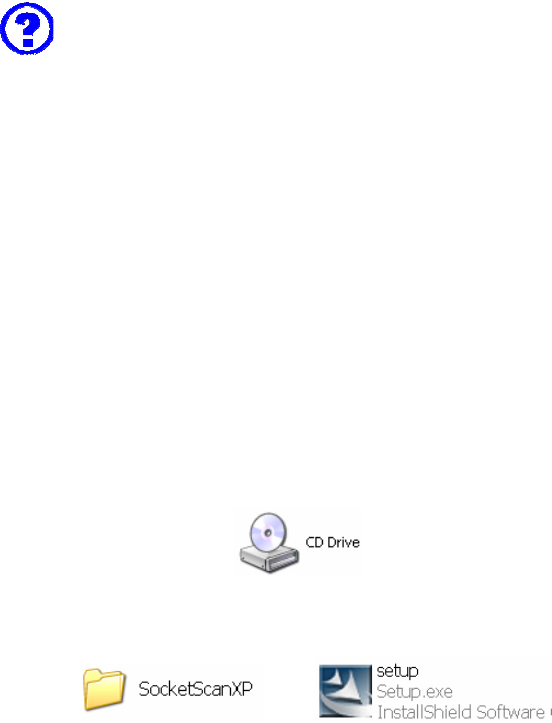
STEP 1: INSTALL THE SOFTWARE
You must install SocketScan, but installing Connect!Agent is optional.
Connect!Agent is only compatible with the IVT BlueSoleil, Toshiba and
Microsoft XP SP2 Bluetooth stacks.
Should I install Connect!Agent?
Connect!Agent simplifies the Bluetooth setup and connection
process. Once the CHS is turned on and SocketScan is
running, Connect!Agent will automatically set up and manage
the Bluetooth connection. It runs in the background and
requires no interaction from the user.
Software installation instructions
ADVANCED USERS: Refer to the README file for CAB installation
instructions.
1. Delete any bar code scanning software already installed in your
computer, including previous versions of SocketScan. Make sure the
software is closed. Click Start | Control Panel | Add or Remove Programs.
Use the utility to delete the software.
2. Insert the SocketScan installation CD into the CD drive of your
computer.
3. Use My Computer or Windows Explorer to access your CD drive.
4. In the CD contents, open the SocketScanXP folder and click on the
Setup.exe file.
CHAPTER 4: SETUP FOR WINDOWS XP 41
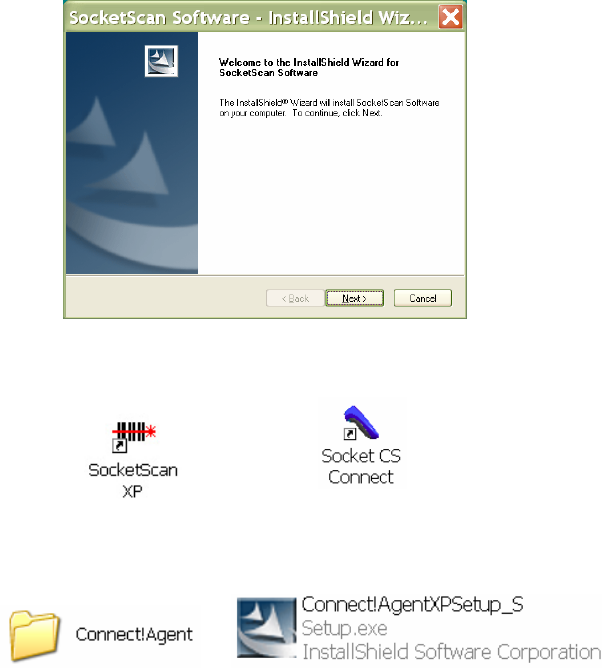
5. The installation wizard will launch. Follow the wizard to install the
software.
6. After software installation, icons for SocketScanXP and Socket CS
Connect will appear on your desktop.
7. If desired, install Connect!Agent by opening the Connect!Agent folder in
the CD and launching the Connect!AgentXPSetup_S.exe file. Follow the
wizard to install the software.
42

STEP 2: CONFIGURE BLUETOOTH SETTINGS
Skip this step if you installed and want to use Connect!Agent, which
automatically configures the Bluetooth settings. Connect!Agent works only
with the Socket (IVT) and Microsoft stacks.
If you will not be using Connect!Agent, follow the appropriate instructions
for your Bluetooth stack. Configuration is only needed the first time you
connect the CHS to your computer.
SocketScan supports a generic Bluetooth COM port and may be able to
connect to Bluetooth stacks on host mobile computers other than those
listed.
Socket Connection Kit with IVT BlueSoleil software:
1. Turn on the Cordless Hand Scanner. Press the small power button for
five seconds, until you see the LED turn blue. The LED should blink
blue once per second to show that the Bluetooth radio is on but not
connected.
2. Insert the Socket card into your computer, using a CF-to-PC Card adapter.
3. Start BlueSoleil. Click on the BlueSoleil icon on your desktop, or click
Start | All Programs | IVT BlueSoleil | BlueSoleil.
4. Click My Bluetooth | Security. Check the box Set Default Passkey and
enter the default PIN 1234 in the field below.
CHAPTER 4: SETUP FOR WINDOWS XP 43

5. Double-click on the red ball to search for the
Cordless Hand Scanner, which will appear as
Socket CHS [xxxxxx].
The characters in brackets are the last 6 characters of the
scanner’s Bluetooth MAC address.
6. Double-click on the Socket CHS icon to begin the service
discovery. After the Serial Port Service icon is highlighted
at the top of the screen, right-click on the Serial Port
Service icon and click Connect.
7. BlueSoleil will ask whether you want to connect to the CHS
automatically when Windows applications open the serial
port. Click Yes.
8. When the devices connect, the CHS will beep once, and the
Bluetooth logo in the task tray will turn green.
9. Click Tools | Configurations | Quick Connect. Choose a COM port
assigned to SPP (Serial Port Profile) and click Assign. In the next screen,
select the CHS and click OK. Remember which COM number you
assigned to the CHS and click OK.
44
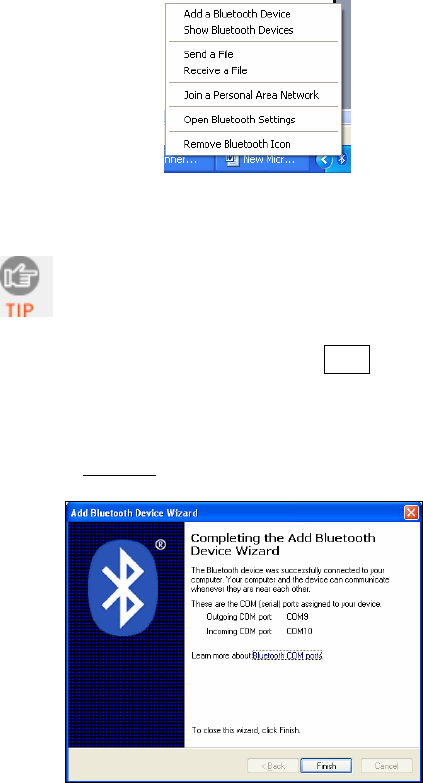
Microsoft Windows XP Service Pack 2:
Refer to the documentation for your Bluetooth hardware/software for
instructions on discovering and connecting to the CHS.
1. Turn on the Cordless Hand Scanner. Press the small power button for five
seconds, until you see the LED turn blue. The LED should blink blue once
per second to show that the Bluetooth radio is on but not connected.
2. Turn on the Bluetooth radio of your computer.
3. Use the Add Bluetooth Device Wizard to discover and connect to the
Cordless Hand Scanner. Click on the Bluetooth icon in the task tray. In
the pop-up menu, click Add a Bluetooth Device.
4. During the device discovery, the Cordless Hand Scanner will appear as
Socket CHS [xxxxxx]
The characters in brackets are the last 6 characters of the
scanner’s Bluetooth MAC address.
5. In the passkey options screen, select the option Use the passkey found in
the documentation and enter the default PIN 1234.
6. To indicate the connection, the CHS will beep once.
7. In the last screen of the Add Bluetooth Device Wizard, note the COM
number of the Outgoing COM port.
CHAPTER 4: SETUP FOR WINDOWS XP 45
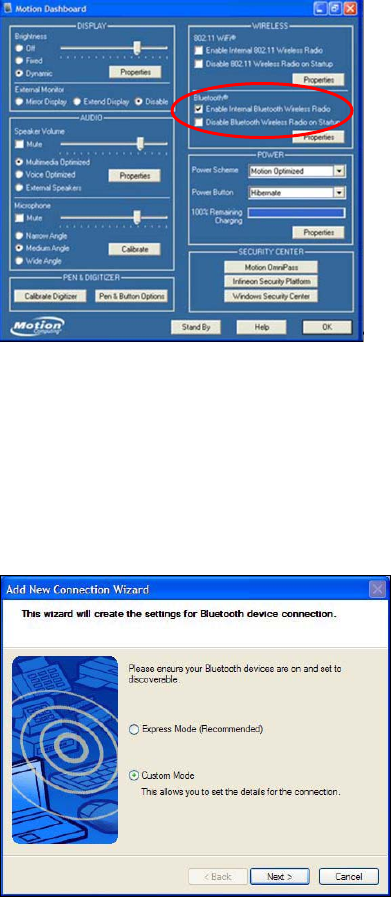
Toshiba Bluetooth Stack:
These instructions are based on a Motion Computing tablet. Refer to the manual
for your Bluetooth hardware/software for specific Bluetooth usage instructions.
1. Turn on the Bluetooth radio of your computer. Tap on the Dashboard icon
on the desktop. In the dashboard, check Enable Internal Bluetooth Wireless
Radio. Tap OK.
2. Turn on the Cordless Hand Scanner. Press the small power button for five
seconds, until you see the LED turn blue. The LED should blink blue once
per second to show that the Bluetooth radio is on but not connected.
3. Double-tap on the Bluetooth icon at the bottom of your screen.
4. In Bluetooth Settings, tap New Connection at the bottom of the screen.
5. The Add New Connection Wizard will launch. Select Custom Mode and
tap Next. The tablet will begin searching for Bluetooth devices in range.
46

6. In the list of found devices, select Socket CHS [xxxxxx]. Tap Next.
7. If a passkey is requested, enter the default PIN 1234. Tap OK. To indicate
the connection, the CHS will beep once.
8. In the list of device services, select Serial Port. Tap Next.
9. Note which COM port is assigned to the CHS.
CHAPTER 4: SETUP FOR WINDOWS XP 47
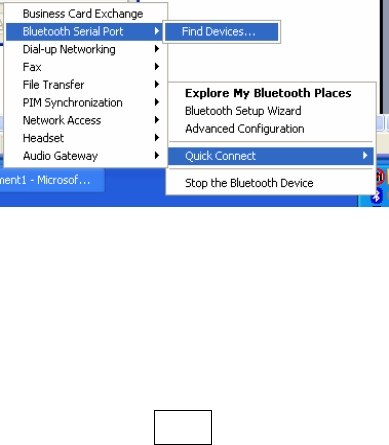
Broadcom (Widcomm) Bluetooth Stack:
Refer to the manual for your Bluetooth hardware/software for specific
instructions. Many Bluetooth USB adapters use this stack.
1. Turn on the Bluetooth radio of your computer.
2. Turn on the Cordless Hand Scanner. Press the small power button for
five seconds, until you see the LED turn blue. The LED should blink
blue once per second to show that the Bluetooth radio is on but not
connected.
3. Perform a Quick Connect to a Bluetooth Serial Port. Click the Bluetooth
icon in the task tray. Click Quick Connect | Bluetooth Serial Port | Find
Devices.
It is essential to connect to the CHS via Quick Connect because this sets
the CHS as your default Bluetooth serial device.
4. During the device search, the CHS will appear as Socket CHS [xxxxxx]
The characters in brackets are the last 6 characters of the scanner’s
Bluetooth MAC address.
5. If a passkey is requested, enter 1234. To indicate the connection, the
CHS will beep once.
By default, the Bluetooth software will ask you for the passkey each time
you connect. To stop the automatic prompts, under Advanced
Configuration, disable the Secure Connection requirement for both the
Local Service and Client Application, then unpair the devices. Refer to
the documentation for your Bluetooth hardware/software for complete
instructions.
48

STEP 3: CONFIGURE SCANNER SETTINGS
1. Click the SocketScan icon at the bottom of the screen. In the pop-up
menu, click Settings.
Alternatively, click Start | Control Panel | SocketScanXP Settings.
2. Tap on the CS tab. Enter the following settings:
• Enable CS support: Check this box. IMPORTANT!!!
• Enable ActivePairing: This feature is not compatible with the CHS. Do
not check the box.
• Bluetooth stack: Select Socket (Connect!Agent) if you want to use it.
Otherwise, select your computer’s Bluetooth stack. The
Connect!Agent option will only appear if you installed the
Connect!Agent software.
CHAPTER 4: SETUP FOR WINDOWS XP 49
• COM Port: Select the COM port number assigned to the CHS. This
field will only appear for some Bluetooth stacks.
• CS trigger operation: Select whether you want the CHS to scan only
when a Bluetooth connection to the device is detected. If you select
• Scan only when connected to host, scanning will be a few
milliseconds slower.
• Good read indication on CS: Select how you would like the CHS to
indicate that it has successfully read data.
• Auto re-connect: Select the maximum number of attempts and time
limit per attempt for the CHS to try to reconnect to your computer in
case they are moved out of range from each other.
• Battery Level: No progress bar should appear since you are not
connected to the CHS.
• Power management: The CHS automatically shuts off if there is no
Bluetooth connection for 20 minutes. Check to disable.
• Advanced: When the computer is connected to the CHS, you can
modify the Bluetooth friendly name and security settings of the CHS.
3. After entering settings, click OK to save the changes.
4. If SocketScan is open, you will be prompted to exit and restart SocketScan.
Click OK. Click on the SocketScan icon at the bottom of your screen and in
the pop-up menu, click Exit.
50
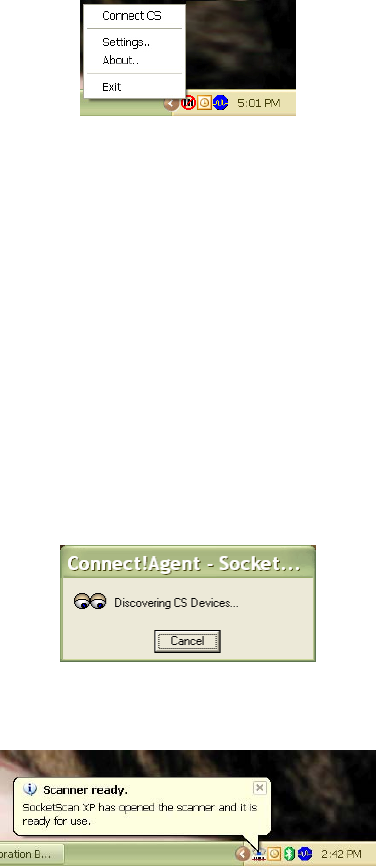
STEP 4: START SOCKETSCAN AND CONNECT TO CHS
1. If you did not install Connect!Agent start your computer’s Bluetooth
software and make sure the Bluetooth radio is turned on.
2. Right-click the SocketScan icon at the bottom of the screen and click
Connect CS.
If you installed Connect!Agent, it will automatically open the Bluetooth
software and turn on the Bluetooth radio when you click Connect CS.
After you configure the correct Bluetooth hardware settings in
SocketScan, the Connect CS menu option allows you to connect to the
CHS directly from SocketScan, instead of manually connecting via
your Bluetooth software.
The Connect CS option will not appear unless you checked the box
Enable CS Support in the SocketScanXP settings.
SocketScan will not be able to connect to the CHS if you have another
device assigned as your favorite or default Bluetooth serial device.
3. If you are using Connect!Agent, and this is your first time connecting,
Connect!Agent will automatically begin searching for the CHS. After it
finds the CHS, it will automatically configure the connection.
4. SocketScan will connect the computer to the CHS,
indicated by a beep and a status bubble.
CHAPTER 4: SETUP FOR WINDOWS XP 51
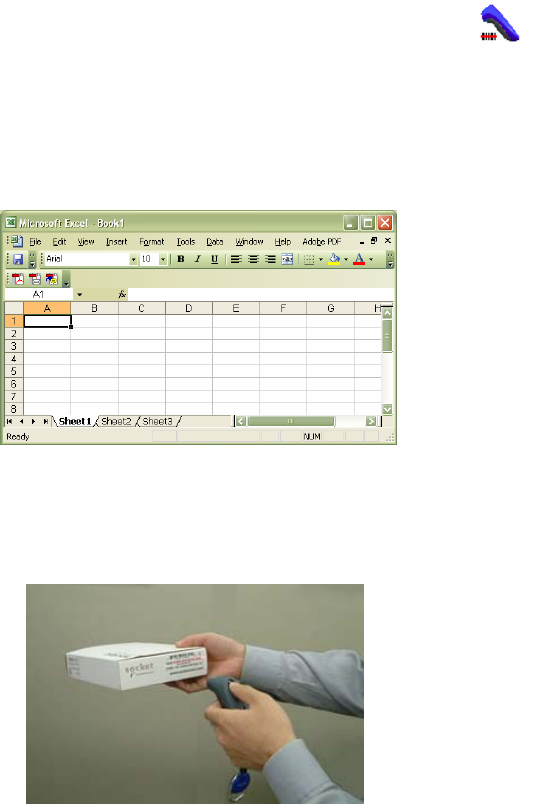
5. The task tray icon at the bottom of your screen will change
to an image of a scanner to indicate that SocketScan is
connected to the CHS.
STEP 5: SCAN DATA INTO YOUR APPLICATION
1. Start the Windows application that you want to enter scanned data into
(e.g., Excel, Notepad, etc.). Make sure a document or spreadsheet is
open.
2. Place the cursor where you want data from the next scan to be entered.
3. Press the trigger button and aim your finger at the bar code. The red
laser beam should cover the entire width of the bar code. See Chapter 1
for scanning tips.
When data is read and sent to the mobile computing device, the laser
will turn off. Depending on your scanner settings, the scanner may beep
and/or the Hand scanner’s LED may flash green to indicate a good
read.
If no data is read in a few seconds, the laser will turn off, and you must
try again.
52
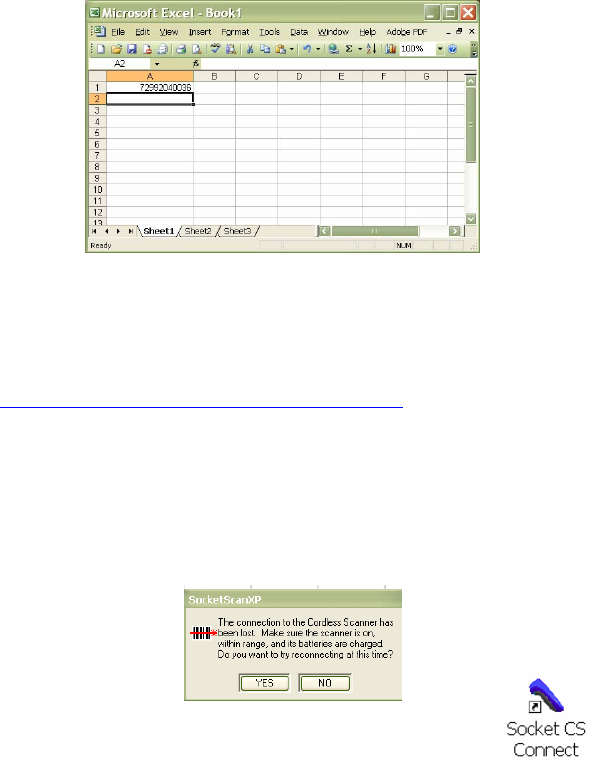
4. After a successful scan, data should appear in your document. By default,
the cursor automatically advances to the next cell or line, ready for the
next scan.
Wait for the “Good Scan” indication before you scan another bar code.
If you try to scan too fast, the device can lock up until you stop scanning.
For information about third-party applications compatible with the CHS
for asset tracking, warehouse mobility, and other vertical markets, visit:
www.socketmobile.com/solutions/vertical-markets
Reconnecting
If your computer suspends or the CHS is moved out of range, the
connection will be lost. After the computer turns on again or returns in
range, SocketScan will try to re-connect according to the “auto re-
connect” settings you chose in SocketScan.
After the time limit for re-connection attempts has passed,
you can click on the Socket CS Connect icon on the
desktop to manually initiate re-connection.
Disconnecting
To disconnect, click on the SocketScan icon and click Disconnect CS.
Turning off the CHS
To turn off the CHS, press the power button for at least 2 seconds, until
the LED stops blinking.
CHAPTER 4: SETUP FOR WINDOWS XP 53

ASSIGNING SOUND AND PREFIX/SUFFIX SETTINGS
You can configure these settings whether or not the CHS is connected
to your computer.
1. In SocketScanXP Settings, click on the General tab.
2. Adjust any settings as desired:
Good read notification sound:
Select which sound you would like your computer to use to indicate
good readings of data. By default, your computer will beep.
• If you would like your computer to play a .WAV file, select Play a
.WAV file and click Browse to indicate the file location.
Prefix/Suffix:
Enter any prefix and/or suffixes you would like SocketScan to automatically
append to scanned data (128 character max., printable ASCII characters only).
By default, SocketScan will enter a carriage return after every data scan.
• Use \r for Carriage Return, \n for Linefeed, \t for Tab., \\ for a single \
character.
• Other characters can be typed or entered using the format \nnn, where
nnn = ASCII character 001 through 255.
3. After adjusting any settings, click OK. As prompted, exit and restart
SocketScanXP to have your changes take effect.
54
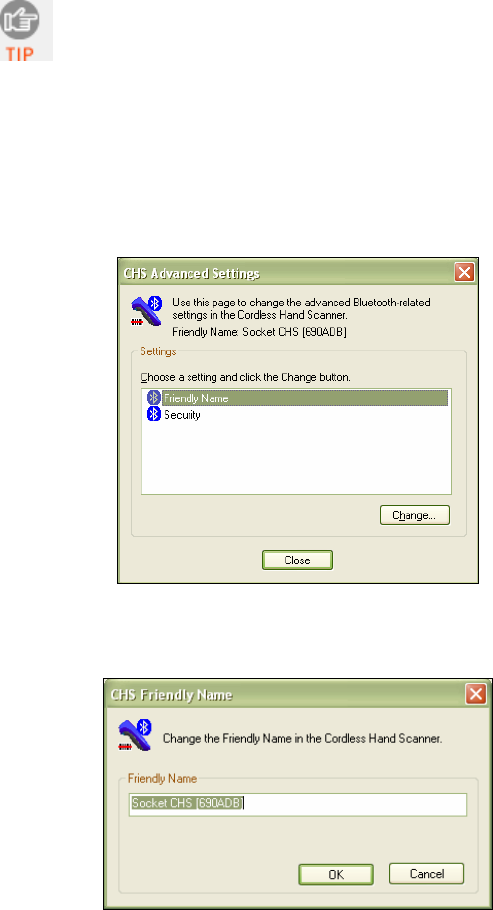
CONFIGURING ADVANCED BLUETOOTH SETTINGS
The SocketScanXP utility enables you configure advanced Bluetooth settings of
the CHS, including the Bluetooth friendly name and security settings.
1. In SocketScanXP Settings, click on the CS tab.
The Trigger and Barcodes tabs will only appear if you are
connected to the CHS.
2. At the bottom of the CS screen, the CHS battery level will be indicated
by a status bar. Click Advanced.
3. The CHS Advanced Settings screen will appear, reporting the current
Bluetooth friendly name assigned to the CHS.
4. If desired, select Friendly Name or Security and click Change.
5. In the screen that appears, enter any changes and click OK.
CHS Friendly Name: Enter a new friendly name and click OK.
CHAPTER 4: SETUP FOR WINDOWS XP 55

CHS Security Settings: Enter a PIN code and/or any authentication or
encryption settings. If desired, click Delete Bonding to delete any
bonding/pairing information in the CHS. After making any changes, click
OK.
6. If you modified any security settings, you will be prompted to turn your CHS
off and back on to make the changes take effect. Read the message and click
OK. Turn the CHS off and back on again.
7. When you return to the CHS Advanced Settings screen, click Close.
8. In the SocketScanXP Settings screen, click OK.
9. Exit and restart SocketScanXP to have your changes take effect.
56
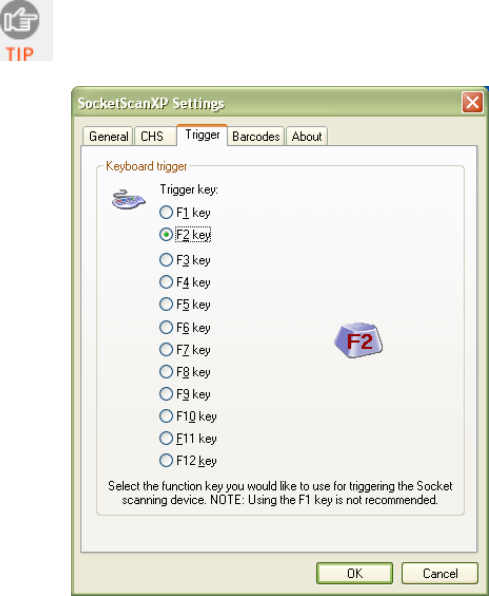
ASSIGNING A TRIGGER BUTTON
The SocketScanXP utility enables you to assign one of your computer’s
function keys to trigger the CHS.
1. In SocketScanXP Settings, click on the Trigger tab.
The Trigger and Barcodes tabs will only appear if you are
connected to the CHS.
2. Select the function key you would like to use as a trigger key. Click OK.
3. As prompted, exit and restart SocketScanXP to have your changes take
effect.
CHAPTER 4: SETUP FOR WINDOWS XP 57

SELECTING SYMBOLOGIES
The SocketScanXP utility makes it easy to modify which symbologies you
want the scanner to recognize and decode.
1. In SocketScanXP Settings, click on the Barcodes tab.
The Trigger and Barcodes tabs will only appear if you are
connected to the CHS.
2. Check the symbologies you wish to enable. Uncheck those you wish to
disable. Click OK.
Enabling all possible symbologies will make the decode
process slightly longer.
3. As prompted, exit and restart SocketScanXP to have your changes take
effect.
58
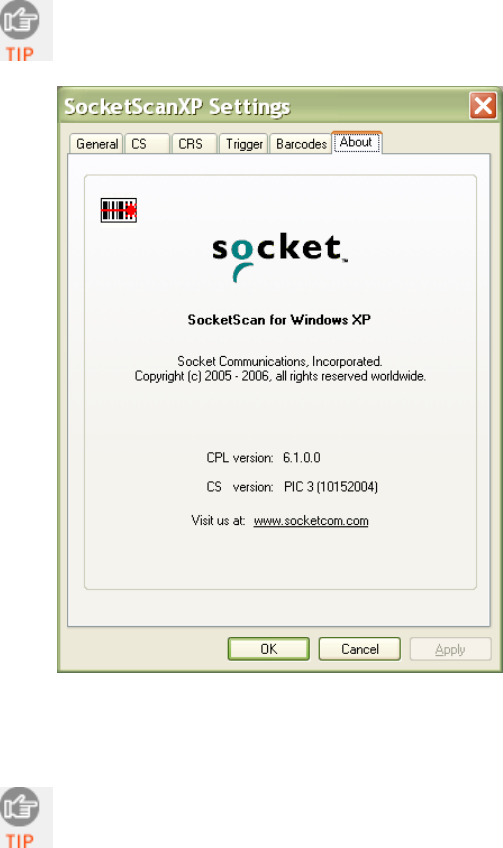
VIEWING VERSION INFORMATION
1. In SocketScanXP Settings, click on the About tab.
The Trigger and Barcodes tabs will only appear if you are
connected to the CHS.
2. View the control panel applet (CPL) and CHS firmware version information.
Click OK.
To view the SocketScan software version, click on the
SocketScan icon and in the menu, click About.
CHAPTER 4: SETUP FOR WINDOWS XP 59

APPENDIX A
SPECIFICATIONS
Physical Characteristics
Size: 125l x 31h x 35w (mm) 4.9l x 1.2h x 1.4w (in.)
Total Mass: approx. 90 g (0.2 lb)
Power Source: Two AAA NiMH rechargeable batteries
Expected Battery Life with Normal Operation (connected via Bluetooth and
minimum 2,000 bar code scans): 8 hours
Operating Temp: 32 to 120°F (0 to 50°C)
Operating System Support:
• Windows Mobile 2003, 2003SE, 5.0
• Windows XP, XP Tablet Edition
• Palm OS v5.2 and later
For information about using the CHS with Symbian OS, please visit:
www.socketmobile.com/products/bar-code-scanning-data-
collection/series7/
2005 Sunrise Date Compliant
Scanning Characteristics
Bar Code Symbologies Decoded:
CHS 7E:
Code 39, UPC/EAN/JAN, MSI, Code 128, Code 93, Codabar, I 2 of 5,
D 2 of 5
CHS 7M/7P:
Code 39, UPC/EAN/JAN, MSI, Code 128, Code 93, Codabar, I 2 of 5,
D 2 of 5, RSS-14, RSS Limited/Extended Stacked, Chinese 2 of 5
Scanner Type:
CHS 7E: CMOS linear imager
CHS 7M: Class 1 laser
CHS 7P: Class 2 laser
Laser Scan Angle: 46.5°
Laser Scanner Performance:
Scan Repetition Rate: 100 scans/sec (bi-directional)
Decode Distances (depends on symbol size, symbology, label media, W-N
Ratio, scan angle)
CHS 7E: 2.2 to 24 inches typical
60 | APPENDIX A: SPECIFICATIONS
CHS 7M: 1.00 to 35.00 inches typical
CHS 7P: 1.00 to 45.00 inches typical
Bluetooth Characteristics
Protocol: Bluetooth 2.45 GHz ISM band frequency hopping
Antenna: Integrated
Radio Range: Up to 330 ft (100 m), depending on environment
Connection: Point-to-point Security: Encrypted link
RF Power: Class 1 radio; Typical Output: 14 dbm
Bluetooth Stack Support
• Socket Drakar v1.4 (from Socket SD/CF Connection Kit)
• IVT BlueSoleil v1.6.1.4 or greater (from Socket CF + Adapter
Connection Kit)
• Broadcom (Widcomm) v1.5 or greater for Windows Mobile
2003/2003SE
• Broadcom (Widcomm) v1.7 or greater for Windows Mobile 5.0
• Broadcom (Widcomm) Bluetooth stack for Windows XP
• Microsoft Bluetooth stack for Windows Mobile
• Microsoft Windows XP SP 2
• Palm Bluetooth Stack
• Toshiba Bluetooth stack 3.0 or greater
Certification/Compliance
FCC: Part 15, Class B CE: EN55024:1998
C-TICK: s.182 Bluetooth 1.1 TELEC
ETS 300 328 ETS 300 826
About Bluetooth Range
The Cordless Hand Scanner features a powerful Class 1 Bluetooth radio to
provide the maximum possible range. As with all wireless technologies, the
connection range can vary widely depending on many factors such as the
brand and placement of the host device, the type and size of physical
obstacles and the presence and activity level of competing radio
transmissions.
In range testing of the CHS while connected to a variety of typical host
devices with Class 2 radios, functional connection distances from 18 to over
100 feet have been experienced depending on the environment. The
following conditions appear to reduce the Bluetooth connection range:
• The presence of soft, absorbent materials such as paper, fiberglass
insulation, foam material in office cubical walls, carpeting and, to a
lesser extent, even sheetrock and wood construction materials. Hard
materials such as concrete increase the range.
APPENDIX A: SPECIFICATIONS 61
• Human bodies or containers of liquid positioned between the host and
the CHS.
• The presence and activity level of competing Bluetooth or 802.11
(Wi-Fi) systems using the same 2.4 GHz frequency.
• Metal in a grid pattern, such as chain link fencing or chicken wire. This
type of material may block the Bluetooth (or Wi-Fi) signal completely.
62 | APPENDIX A: SPECIFICATIONS

APPENDIX B
SAFETY AND USAGE TIPS
About Bluetooth and Health
Bluetooth wireless technology allows you to use short-range radio signals
to connect a variety of devices, such as bar code scanners, mobile phones,
Pocket PCs, notebook computers, printers, LAN access points, and many
other devices at home or work. These radio signals replace the cables that
have traditionally connected these devices.
Bluetooth products have small radio transmitters and receivers. Output
power is normally very low, only 1 mW (1/1000 of a watt). This gives a
working range of approximately 10 meters.
The maximum exposure levels from Bluetooth products are far below
recommended safety guidelines. At most, typical Bluetooth devices (1mW)
reach only one percent of the prescribed safety levels.
Product Care
• Do not expose your product to liquid, moisture or extreme humidity.
• Do not expose your product to extreme high or low temperatures.
• Do not expose your product to lit candles, cigarettes, or cigars, or to
open flames, etc.
• Do not drop, throw or try to bend the product, as rough treatment could
damage it.
• Do not paint your product, as the paint could obstruct parts and prevent
normal use.
• Do not attempt to disassemble your product: a broken warranty seal will
void the warranty. The product does not contain consumer serviceable
components. Should your Cordless Hand Scanner need service, please
contact Socket technical support at: support@socketcom.com.
• Treat your product with care. Keep in a clean and dust-free place.
• Changes or modifications of this product, not expressly approved by
Socket, may void the user’s authority to operate the equipment.
Antenna Care
Do not place a metallic shield around the Cordless Hand Scanner since it
will reduce the radio transmission efficiency.
APPENDIX B: SAFETY AND USAGE TIPS 63

Efficient Use
For optimum performance, please make sure that there is no metal
surrounding your Cordless Hand Scanner.
Driving
RF energy may affect some electronic systems in motor vehicles, such as
car stereo, safety equipment, etc. Check with your vehicle manufacturer to
be sure that the Cordless Hand Scanner will not affect the vehicle’s
electronics.
Aircraft
• Turn off your Cordless Hand Scanner before boarding any aircraft.
• To prevent interference with communications systems, you must not use
your Cordless Hand Scanner while the plane is in the air.
• Do not use it on the ground without permission from the crew.
Radio Frequency Exposure
Your Cordless Hand Scanner contains a radio transmitter and receiver.
When in operation, it communicates with a Bluetooth enabled mobile
computer by receiving and transmitting radio frequency (RF) magnetic
fields in the frequency range 2400 to 2500 MHz. The output power of the
radio transmitter is 0.001 Watt. The Cordless Hand Scanner is designed to
be in compliance with the RF exposure limits set by national authorities and
international health agencies1 when installed or used separately from other
antennas or radio transmitters.
1 Examples of RF exposure standards and guidelines:
ICNIRP, “Guidelines for limiting exposure to time-varying electric, magnetic, and
electromagnetic fields (up to 300 GHz)”, International Commission on Non-
Ionizing Radiation Protection (ICNIRP), Health Physics, vol. 74, pp 494-533, April
1998.
99/519/EC, EU Council Recommendation on the limitation of exposure to the
general public to electromagnetic fields 0 Hz – 300 GHz, Official Journal of the
European Communities, July 12, 1999.
ANSI/IEEE C95.1-1992, “Safety levels with respect to human exposure to radio
frequency electromagnetic fields, 3 kHz to 300 GHz”, The Institute of Electrical and
Electronics Engineers, Inc., New York, 1991.
FCC Report and Order, ET Docket 93-62, FCC 96-326, Federal Communications
Commission (FCC), August 1996.
Radiocommunications (Electromagnetic Radiation Human Exposure) Standard
1999, Australian Communications Authority (ACA), May 1999.
64
APPENDIX C
BAR CODE LABEL SPECIFICATIONS
All bar code symbols/labels should satisfy the appropriate AIM Uniform
Symbology Specification.
Background Substrate:
The bar code symbol should be printed on material (media) that is reflective
and has a matte (not glossy) finish. A background diffuse reflectance of at
least 70% to 80% is desirable for optimum contrast. Retro-reflective media
should be used to obtain decode distances greater than 36 inches.
Ink Color and Type:
The inked bars should not exceed 25% reflectance at the wavelength that is
being used for reading, whether printed with black ink or colored ink. The
reflectance value should not vary more than 5% within the same character.
Voids and Specks:
The code should be printed clearly, free of voids, specks, blemishes and
lines that could “fool” the scanner. Specks or blemishes in the white
spaces, or false or missing bar sections could be interpreted by the reading
equipment as part of the code. Generally, the width of such flaws is more
serious than the height. Code symbols/ labels should be rejected if these
defects are present.
Definition:
The bars in the bar code symbol should be well defined. Their edges
should not be rough or fuzzy, so that the bars and spaces have the proper
widths intended for the bar code symbology used.
Contrast:
Background reflectance (that of the substrate on which the codes are
printed) should always provide a good contrast relative to the ink
reflectance (that of the code bars). The difference between the two should
be at least 37.5% at the wavelength used for reading.
Tolerance:
The ratio of the widths of bars and spaces in a bar code symbol must
conform to the appropriate AIM bar code specifications and can cause
problems if not correct throughout the bar code. Problems can occur when
bar edges are smeared or rough, or when they exhibit voids.
APPENDIX C: BAR CODE LABEL SPECIFICATIONS 65
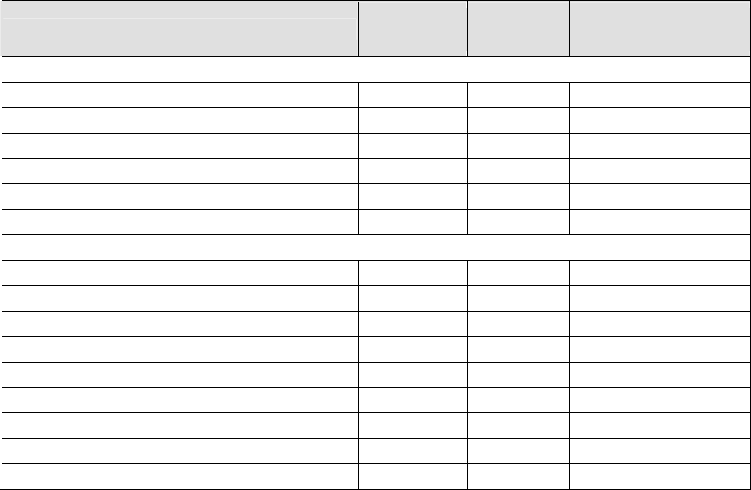
APPENDIX D
ENABLING OR DISABLING SYMBOLOGIES
The Cordless Hand Scanner is pre-set to automatically detect and decode
(auto-discriminate) the most common bar code symbologies. To enable or
disable symbologies, simply use SocketScan’s Symbology Selector.
Notes:
• The length of some symbologies will change after Symbology Selector is
used. See Table 1.
• With more symbologies enabled, the scanner must work harder to search
through all the possible combinations. This may make the decoding process
slightly longer.
• The advanced symbology parameters listed in Table 2 can only be modified
by using the SocketScan Advanced Programming Guide or the SocketScan
SDK. Check Socket’s website for updates.
Table 1. Default Symbologies
Symbology Scanner
Default Default
Length Length after
Symbology Selector
UPC/EAN/JAN
UPC-A Enabled N/A N/A
UPC-E Enabled N/A N/A
UPC-E1 Disabled N/A N/A
EAN-8 Enabled N/A N/A
EAN-13 Enabled N/A N/A
Code 128 (USS-128 & UCC/EAN 128) Enabled Any Any
Code 39*
Code 39 Enabled 2 to 23 2 to 55
Trioptic Code 39 Enabled 2 to 23 2 to 55
Code 39 Full ASCII Disabled 2 to 23 2 to 55
Code 93 Disabled 2 to 38 2 to 55
Interleaved 2 of 5* Enabled 14 Only 2 to 55
Discrete 2 of 5* Disabled 12 Only 2 to 55
Codabar Disabled 5 to 55 2 to 55
MSI Plessey* Disabled 1 to 30 2 to 55
RSS-14 (Standard, Limited, Expanded)** Disabled N/A N/A
*Warning: Setting the length to “Any” may lead to inaccurate decodes of these symbologies.
**This symbology will be added in the next release.
66

Table 2. Other Symbology Parameters
Symbology Parameters Scanner Default
UPC/EAN/JAN
Supplementals Disabled
Transmit Check Digit Enabled
Bookland EAN Disabled
Decode UPC/EAN Supplementals Ignore
UPC/EAN Supplemental Redundancy Seven
Transmit UPC-A Check Digit Enabled
Transmit UPC-E Check Digit Enabled
Transmit UPC-E1 Check Digit Enabled
Convert UPC-E to A Disabled
Convert UPC-E1 to A Disabled
EAN-8 Zero Extend Disabled
UPC/EAN Security Level 0
UPC/EAN Coupon Code Disabled
Code 39
Convert Code 39 to Code 32 Disabled
Code 32 Prefix Disabled
Check Digit Verification Disabled
Transmit Check Digit Disabled
Code 39 Full ASCII Disabled
Interleaved 2 of 5
Check Digit Verification Disabled
Transmit Check Digit Disabled
Convert I 2 of 5 to EAN-13 Disabled
RSS-14 Disabled
RSS-14 Limited Disabled
RSS-14 Expanded Disabled
APPENDIX D: ENABLING/DISABLING SYMBOLOGIES 67
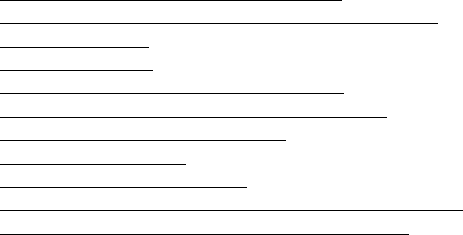
For more information on bar codes, symbologies, labels or other bar code
related topics, visit any of the following web sites:
a. www.aimglobal.org/technologies/barcode/
b. www.aimglobal.org/aimstore/stackedsymbologies.htm
c. www.adams1.com
d. www.bizfonts.com
e. www.barcode-us.com/info_center/upc.htm (UPC Codes)
f. www.barcode-us.com/info_center/bookinfo.htm (Bookland EAN)
g. www.dataid.com/bcsymbology.htm
h. www.aaabarcodes.com
i. www.snx.com/mechanics.html
j. www.pscnet.com/html/aabcsymbologies.htm#Checksums
k. www.idautomation.com/barcoding4beginners.html
68

APPENDIX E
DECODE ZONE
The decode zones for the Cordless Hand Scanner are shown below. The
minimum element width (“X Dimension” or bar code “size”) is the width in
thousandths of an inch (mils) of the narrowest element (bar or space) in the
symbol. The figures shown are the typical scanning distances (depths of
field) for selected bar code sizes. The maximum usable length of a bar code
symbol (Width of Field) at any given range is also shown.
CHS 7M
APPENDIX E: DECODE ZONE 69
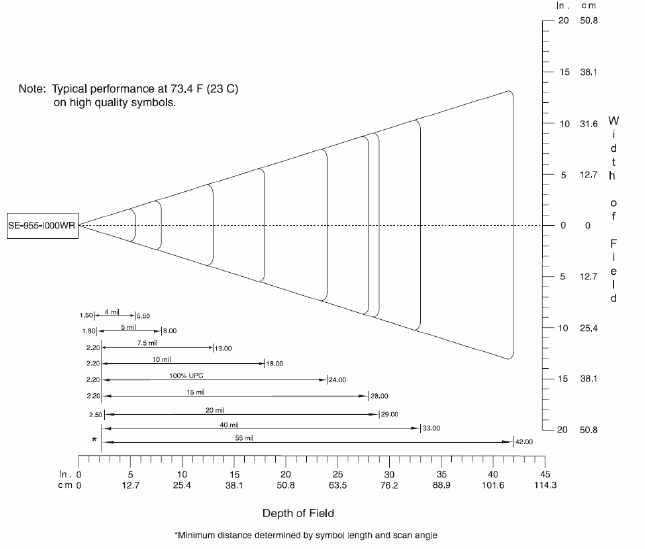
CHS 7P
70 | APPENDIX E: DECODE ZONE
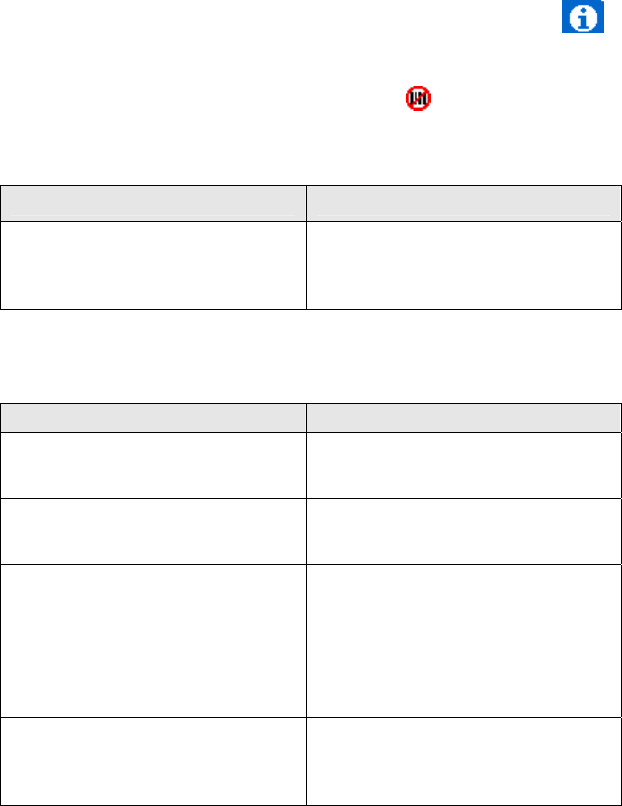
APPENDIX F
TROUBLESHOOTING
For help on SocketScan, tap Start | Help on a Pocket PC, or tap on the
icon on a Palm device.
SYMPTOM: I get the “No Scanner Detected” icon in the task tray
of my Windows-based mobile computer and can’t trigger the laser or
scan any bar codes.
POSSIBLE REASON SOLUTION
Your mobile computer is not
connected to the Cordless Hand
Scanner.
Make sure the Cordless Hand
Scanner is on and in range and
has enough battery power. Try to
reconnect.
SYMPTOM: When I try to scan, the laser activates, but no data
appears on my screen, and the laser eventually turns off.
POSSIBLE REASON SOLUTION
The scanner is too close or too
far from the bar code. Practice so you get accustomed
the most effective distance and
scanning angle.
The bar code is incorrectly
formatted or poorly printed. Try scanning a bar code that is
correctly formatted or printed well,
such as on a retail package.
The bar code symbology may be
disabled or not supported by the
Cordless Hand Scanner.
Use Scan Demo for Windows
Mobile or the Test screen for Palm
OS to identify the symbology. If
needed, enable the symbology by
using Symbology Selector for
Windows Mobile or the Symbology
screen for Palm OS.
You don’t have an application
open to scan data into. Open an application, such as
Excel, and place the cursor where
you want scanned data to go. Try
scanning again.
APPENDIX F: TROUBLESHOOTING 71
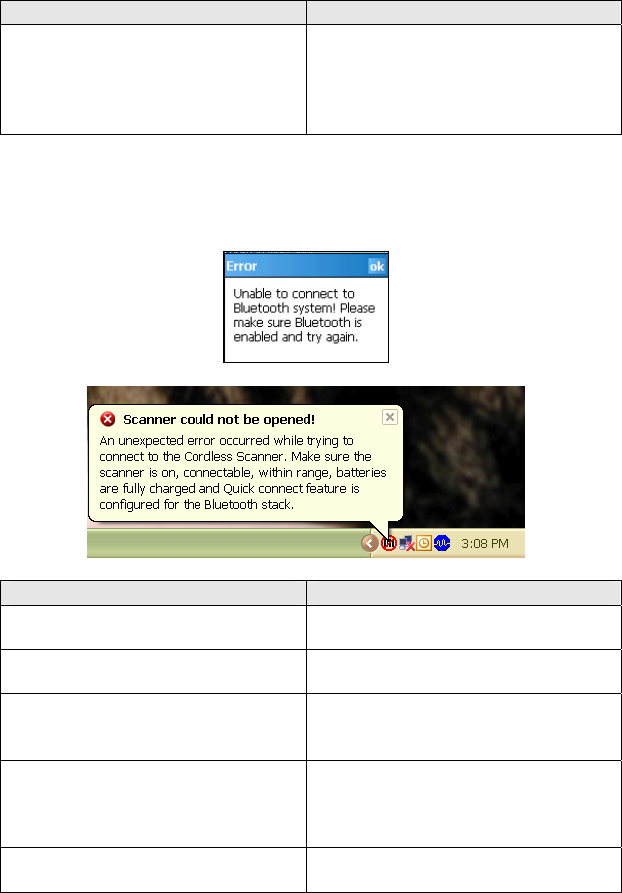
SYMPTOM: When I scan a lot of bar codes very fast, the scanner
locks up and won’t work for a few seconds.
POSSIBLE REASONS SOLUTION
You are scanning too fast for the
Error Proof Protocol to confirm
that the mobile computer has
successfully received each scan
of data.
Wait for the confirmation beep
after each scan before you scan a
new bar code. You may need to
re-scan data that was not correctly
received by the mobile computer.
SYMPTOM: My mobile computer cannot find the Cordless Hand
Scanner, and/or I get an error message saying that there are
connection problems.
POSSIBLE REASONS SOLUTION
You are too far from the Cordless
Hand Scanner. Move the devices closer together,
within a range of 10-15 meters.
The Cordless Hand Scanner is
not turned on. Turn on the Cordless Hand
Scanner.
You have assigned another
device as your favorite or default
Bluetooth serial device.
Remove any settings that assign
another device as your favorite
Bluetooth serial device.
You are using an XP system
without Connect!Agent, and you
did not start the Bluetooth
software.
Start the Bluetooth software.
The Bluetooth radio of your
mobile computer is not turned on. Turn on the Bluetooth radio of
your mobile computer.
72 | APPENDIX F TROUBLESHOOTING
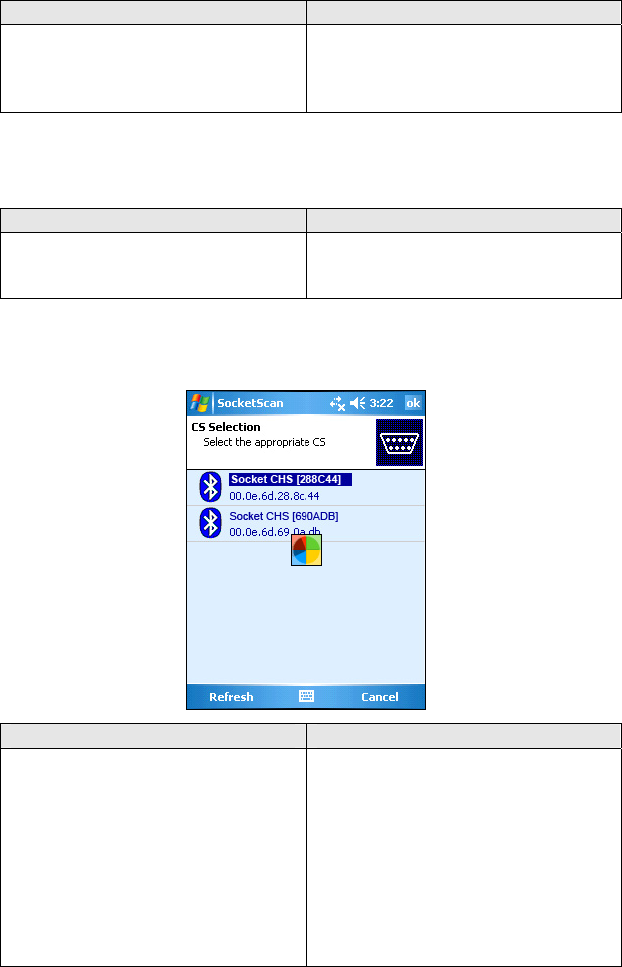
SYMPTOM: While scanning with the CHS, I turned off the Pocket
PC, or my Pocket PC entered suspend mode. Now my Pocket PC
won’t turn on again.
POSSIBLE REASONS SOLUTION
This is a known problem with the
Widcomm stack (built into HP
h221X iPAQ Pocket PCs with
ROM version 1.00).
Soft reset the Pocket PC by
pressing the reset button.
SYMPTOM: My Pocket PC shows an error message saying that
there are insufficient device resources.
POSSIBLE REASONS SOLUTION
Some HP iPAQ Pocket PCs are
not compatible with the Socket
Cordless Hand Scanner.
The CHS will not work with your
Pocket PC at this time.
SYMPTOM: Connect!Agent has found multiple CHS devices, and I
don’t know which one to choose.
POSSIBLE REASONS SOLUTION
This is your first time using
Connect!Agent to connect to a
CHS, and Connect!Agent has
found multiple CHS devices using
the default name.
Turn off the CHS device(s) you do
not want to connect to. Tap
Refresh. Connect!Agent will
connect to and save information
about your CHS to exclusively
connect to it in the future. If you
are using SocketScan XP, you can
use the SocketScan settings utility
to change the Bluetooth friendly
name of your CHS.
APPENDIX F: TROUBLESHOOTING 73

SYMPTOM: While scanning with the CHS, I turned off the Pocket
PC, or my Pocket PC entered suspend mode. Now the CHS won’t
reconnect to my Pocket PC.
POSSIBLE REASONS SOLUTION
There is a problem with the
Widcomm stack on some Pocket
PCs where the CHS can be
discovered but fails to
communicate. Affected units
include the HP iPAQ models
h221X with ROM version 1.10
and h1945.
Soft reset the Pocket PC by
pressing the reset button.
74 | APPENDIX F TROUBLESHOOTING

APPENDIX G
TECHNICAL SUPPORT
Socket On-Line Support (SOS)
SOS is a virtual technical support assistant that can help you with your
product support questions or FAQs. SOS responds immediately to your
inquiry, and no product registration is required to use the system.
To access SOS, please visit: www.socketmobile.com/support/faq/
Human Technical Support
If you have trouble installing or using the Socket Cordless Ring Scanner,
contact Socket’s technical support department for assistance.
IMPORTANT! To obtain technical support, you must first register your
product online at www.socketmobile.com/support/support/new
After you register your product, log in and click on the Technical Support
tab. Click Create New Ticket to submit an online request for technical
support. Afterwards, you can log in anytime to monitor the status of your
request. If we are unable to resolve your support inquiry online, we can
arrange for a technical support representative to call you at a specific time.
.
APPENDIX G: TECHNICAL SUPPORT | 75

LIMITED WARRANTY
Socket Communications Incorporated (Socket) warrants this product against defects
in material and workmanship, under normal use and service, for one (1) year from
the date of purchase.
EXCLUDES: Consumables such as batteries, removable cables, cases, straps,
chargers, and CF-to-PC Card adapters (90 day coverage only)
Incompatibility is not a defect covered by Socket’s warranty. During the warranty
period, Socket will, at its option, repair or replace the defective product at no charge
when furnished with proof of retail purchase, provided that you deliver the product
to Socket or to an authorized Socket Service Center.
The returned product must be accompanied by a return material authorization
(RMA) number issued by Socket or by Socket's Authorized Service Center. If you
ship the product, you must use the original container or equivalent and you must pay
the shipping charges to Socket. Socket will pay surface shipping charges back to
any location in the contiguous United States. This warranty applies only to the
original retail purchaser and is not transferable.
Socket may, at its option, replace or repair the product with new or reconditioned
parts and the returned product becomes Socket's property. Socket warrants the
repaired or replaced products to be free from defects in material or workmanship for
ninety (90) days after the return shipping date, or for the remainder of the original
warranty period, whichever is greater.
This warranty does not cover the replacement of products damaged by abuse,
accident, misuse or misapplication, nor as a result of service or modification other
than by Socket. This warranty is void if you install batteries into the product that
were not supplied by Socket.
SOCKET IS NOT RESPONSIBLE FOR INCIDENTAL OR CONSEQUENTIAL
DAMAGES RESULTING FROM BREACH OF ANY EXPRESS OR IMPLIED
WARRANTY, INCLUDING DAMAGE TO PROPERTY AND, TO THE EXTENT
PERMITTED BY LAW, DAMAGES FOR PERSONAL INJURY. THIS
WARRANTY IS IN LIEU OF ALL OTHER WARRANTIES INCLUDING
IMPLIED WARRANTIES OF MERCHANTABILITY AND FITNESS FOR A
PARTICULAR PURPOSE.
Some states do not allow limitation of implied warranties, or the exclusion or
limitation of incidental or consequential damages, so that the above limitations or
exclusions may not apply to you. This warranty gives you specific legal rights and
you may also have other rights which vary from state to state.
This product may contain fully tested, recycled parts, warranted as if new.
For warranty information, please visit: www.socketmobile.com/support
76
LIMITED SOFTWARE WARRANTY
LIMITED WARRANTY. SOCKET warrants that the original disk or CD ROM is
free from defects for 90 days from the date of delivery of the SOFTWARE.
CUSTOMER REMEDIES. SOCKET’S entire liability and your exclusive remedy
shall be, at SOCKET’S option, either (a) return of the price paid or (b) replacement
of the SOFTWARE which does not meet SOCKET’S Limited Warranty and which
is returned to SOCKET with a copy of your receipt. Any replacement SOFTWARE
will be warranted for the remainder of the original warranty period or 30 days,
whichever is longer. THESE REMEDIES ARE NOT AVAILABLE OUTSIDE OF
THE UNITED STATES OF AMERICA.
NO OTHER WARRANTIES. SOCKET disclaims all other warranties, either
express or implied, including but not limited to implied warranties of
merchantability and fitness for a particular purpose, with respect to the
SOFTWARE and the accompanying written materials. This limited warranty gives
you specific legal rights. You may have others which vary from state to state.
NO LIABILITY FOR CONSEQUENTIAL DAMAGES. In no event shall SOCKET
or its suppliers be liable for any damages whatsoever (including, without limitation,
damages for loss of business profits, business interruption, loss of business
information, or other pecuniary loss) arising out of the use of or inability to use the
SOFTWARE, even if SOCKET has been advised of the possibility of such
damages. Because some states do not allow the exclusion or limitation of liability
for consequential or incidental damages, the above limitation may not apply to you.
EXPORT LAW ASSURANCES. You may not use or otherwise export or reexport
the SOFTWARE except as authorized by United States law and laws of the
jurisdiction in which the SOFTWARE was obtained. In particular, but without
limitation, none of the SOFTWARE may be used or otherwise exported or
reexported (a) into (or to a national or resident of) a United States embargoed
country or (b) to anyone on the U.S. Treasury Department’s list of Specially
Designated Nationals or the U.S. Department of Commerce’s Table of Denial
Orders. By using the SOFTWARE, you represent and warrant that you are not
located in, under control of, or a national or resident of any such country or on any
such list.
GOVERNMENT END USERS. If the SOFTWARE is supplied to the U. S.
Government, the SOFTWARE is classified as “restricted computer software” as
defined in clause 52.227-19 of the FAR. The U. S. Government ‘s rights to the
SOFTWARE are as provided in clause 52.227-19 of the FAR.
CONTROLLING LAW AND SEVERABILITY. This License shall be
governed by the laws of the United States and the State of California. If for
any reason a court of competent jurisdiction finds any provision, or portion
thereof, to be unenforceable, the remainder of this License shall continue in
full force and effect.
77

REGULATORY COMPLIANCE
The Socket Cordless Hand Scanner is designed to be compliant with the
rules and regulations in locations where they are sold and will be labeled as
required. This product is type approved — users are not required to obtain
license or authorization before using.
This product has been certified as conforming to technological standards.
Therefore, the following actions are punishable by law:
• Disassembly or modification of this product
• Removal of identification labels on the back of the product
The frequency used by this product is also used by industrial, scientific and
medical devices, such as microwave ovens, as well as wireless detectors for
motion detectors, such as those requiring licenses used on manufacturing
lines or similar radio transmitters (all of these wireless devices will be
called “other wireless transmitters” below). Most modern electronic
equipment (e.g., in hospitals and cars), is shielded from RF energy.
However, certain electronic equipment is not.
1. Please ensure that all medical devices used in proximity to this device
meet appropriate susceptibility specifications for this type of RF energy.
2. In the unlikely event that there is electronic interference between this
system and other wireless transmitters, quickly change the location of
operation or stop operating the unit (cease signal transmission).
3. If other electrical interference or related problems occur, contact Socket
technical support at www.socketmobile.com/support/support
Radio Frequency Interference Requirements
This device complies with part 15 of the FCC rules and Industry Canada.
Operation is subject to the following conditions: (1) This device may not
cause harmful interference, and (2) this device must accept any interference
received, including interference that may cause undesired operation.
This equipment is also ETS EN300 328-2, ETS EN301 489-1 and ETS
EN301 489-17 compliant. These limits are designed to provide reasonable
protection against harmful interference when the equipment is operated in a
commercial environment.
This equipment generates, uses, and can radiate radio frequency energy
and, if not installed and used in accordance with the instruction manual,
may cause harmful interference to radio communications. Operation of this
equipment in a residential area is likely to cause harmful interference, in
which case the user will be required to correct the interference at his or her
own expense.
78
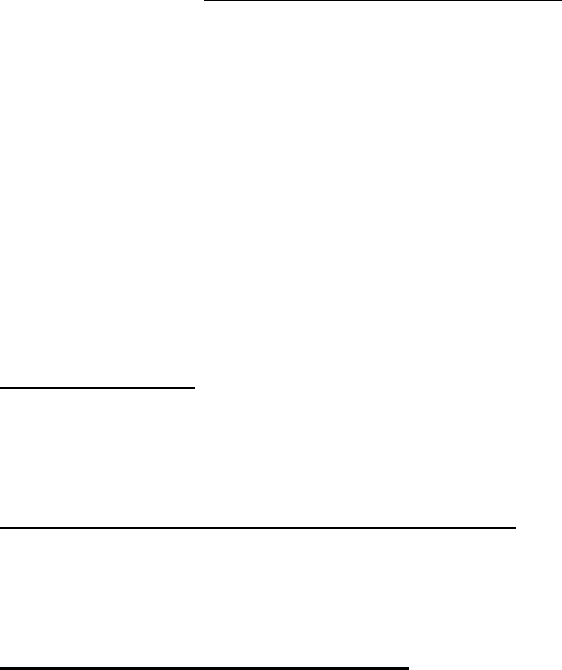
This equipment generates and radiates radio-frequency energy. To comply
with FCC RF exposure compliance requirements, the following antenna
installation and device operating configurations must be satisfied: (1) Users
are not permitted to make changes or modify the system in any way, and (2)
connecting external antennas to the Cordless Hand Scanner is prohibited.
This device and its antenna must not be co-located or operated with any
other antenna or transmitter.
To comply with Industry Canada RF exposure compliance requirements, the
following antenna installation and device operating configurations must be
satisfied: “The installer of this radio equipment must ensure that the antenna
is located or pointed such that it does not emit RF field in excess of Health
Canada limits for the general population; consult Safety Code 6, available at
Health Canada’s website www.hc-sc.gc.ca/ehp/ehd/catalogue/rpb.htm”
If this equipment does cause harmful interference to radio or television
reception, which can be determined by turning the equipment off and on,
the user may try to correct the interference by one or more of the following
measures:
• Reorient or relocate the receiving antenna of the radio or television.
• Increase the distance separating the equipment and the receiver.
• Connect the equipment to an outlet on a different branch circuit than that
of the receiver.
• Consult the dealer or an experienced radio/TV technician for help.
The user may find the following booklet helpful: How to Identify and
Resolve Radio-TV Interference Problems. This booklet is available from the
U.S. Government Printing Office, Washington, D.C. 20402.
Canada Certification
The marking of “IC:xxxxxx-yyyyyy” on the device means: “xxxxxx-
yyyyyy” is the certification number, and the term “IC’ before the equipment
certification number only signifies that Industry Canada technical
specifications were met.
Radio Frequency Interference Requirements – Canada
This Class B digital apparatus meets the requirements of the Canadian
Interference-Causing Equipment Regulations. Cet appareil numérique de la
Classe B respecte toutes les exigencies du Reglement sur le Matériel
Brouilleur du Canada.
CE Marking & European Union Compliance
Products intended for sale within the European Union are marked with a
CE Mark which indicates compliance to applicable Directives and
79

European Normes (EN), as follows. Amendments to these Directives or
ENs are included: Normes (EN), as follows:
Applicable Directives:
• Radio and Telecommunications Terminal Equipment Directive
1999/5/EC
• Low Voltage Directive 73/23/EEC
Applicable Standards:
• EN 55 022 – Limits and Methods of Measurement of Radio Interference
Characteristics of Information Technology Equipment.
• EN 50 082-1 – Electromagnetic Compatibility – General Immunity
Standard, Part 1: Residential, Commercial, Light Industry.
• IEC 801.2 – Electromagnetic Compatibility for Industrial Process
Measurement and Control Equipment, Part 2: Electrostatic Discharge
Requirements.
• IEC 801.3 – Electromagnetic Compatibility for Industrial Process
Measurement and Control Equipment, Part 3: Radiated Electromagnetic
Field Requirements.
• IEC 801.4 - Electromagnetic Compatibility for Industrial Process
Measurement and Control Equipment, Part 4: Electrical Fast Transients
Requirements
• EN 60 950 + Amd 1 + Amd 2 – Safety of Information Technology
Equipment Including Business Equipment.
LASER DEVICE:
The Socket Cordless Hand Scanner 7M and 7P described in this User Guide
contain a Symbol SE955 laser scan engine.
For the Class 1 version of this engine (CHS 7M), the following applies:
• “Complies with 21CFR1040.10 and 1040.11 except for deviations
pursuant to Laser Notice No. 50, dated July 26, 2001. “
• “EN60825-1:1994+ A1:2002 +A2:2001”
• “IEC60825-1:1993+A1:1997+A2:2001”
• “Class 1 Laser devices are not considered to be hazardous when
used for their intended purpose. The following statement is
required to comply with US and international regulations:
Caution: Use of controls, adjustments or performance of
procedures other than those specified herein may result in
hazardous laser light exposure.”
80

A label such as the one below should appear on the end product.
Example of Class 1 Laser Warning Label
For the Class 2 version of this engine (CHS 7P), the following applies:
• “Complies with 21CFR1040.10 and 1040.11 except for deviations
pursuant to Laser Notice No. 50, dated July 26, 2001.”
• “EN60825-1:1994+ A1:2002 +A2:2001”
• “IEC60825-1:1993+A1:1997+A2:2001”
• “Caution: Use of controls, adjustments or performance of
procedures other than those specified herein may result in
hazardous laser light exposure.
• Class 2 laser scanners use a low power, visible light diode. As with
any very bright light source, such as the sun, the user should avoid
staring directly into the light beam. Momentary exposure to a
Class 2 laser is not known to be harmful.”
A label such as the one below should appear on the end product.
Example of Class 2 Laser Warning Label
81
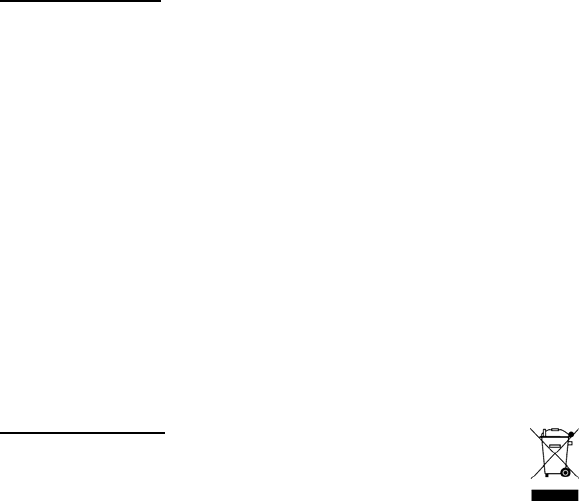
Battery Warning:
• Your device contains a rechargeable NiMH battery. Never throw the
battery into a fire, as that could cause the battery to explode.
• Never short-circuit the battery by bringing the terminals in contact with
another metal object. This could cause personal injury or a fire, and
could also damage the battery.
• Never dispose of used battery with other ordinary solid wastes.
Batteries contain toxic substances.
• Dispose of used battery in accordance with the prevailing community
regulations that apply to the disposal of batteries. Cover the metal
terminals with insulating tape. (This is to prevent accidental short-
circuiting).
• Never expose the battery to any liquid.
• Always keep the battery out of reach of infants or small children.
• Never shock the battery by dropping it or throwing it.
• Dispose of a spent or damaged battery promptly.
Product Disposal
Your device should not be placed in municipal waste. Please
check local regulations for disposal of electronic products.
82
5/2007 Printed in U.S.A.